Our road trip consisted of adventures, misadventures, bad roads, good roads, in-between roads, and a lot of interesting and beautiful sights. Before we get into the details, here is a summary of what ended up being our itinerary:
Starting and ending point: Orikum
Day 1: Pick up rental car. Llogara Pass, Lamani Beach, Himarë a.k.a. Himara (overnight in Himarë)
Day 2: Porto Palermo, The 40 Saints Monastery, Lëkursi Castle, Sarandë a.k.a. Saranda (overnight in Sarandë)
Day 3: Butrint Archaeological Park, Ksamil (for the beach), and the Sarandë Blue Eye. Drove to Gjirokaster in the evening (overnight in Gjirokaster)
Day 4: Gjirokaster (second overnight in Gjirokaster)
Days 5 and 6: Berat (overnight two nights)
Day 7: Tirana (overnight one night)
Day 8: Kruje, Shkodër (overnight in Shkodër)
Day 9: Shkodër (this was supposed to have been Theth National Park – it wasn’t) (overnight in Shkodër)
Days 10, 11: Valbonë a.k.a. Valbona (overnight on day 10). Returned to Shkodër and drove to Golem (overnight in Golem)
Day 12: Return to Orikum by 8:00 a.m. to return rental car (we aren’t counting this day in our road trip)
Today’s post covers the first two days.
Let me first say that this was an aggressive and optimistic road trip. We wanted to see a lot of the country since we will probably never visit here again. So, we decided to go with the “drink from a firehose” approach. Ideally, this would have been a two-week road trip. It worked out – except for when our rental car wouldn’t start so we couldn’t go to Theth National Park!! – but it would have felt a tad more leisurely had we had three more days. We will tell you what went well, what went awry, and we will encourage you to visit this astounding country!
First, we needed a car. We rented a car from a store in Orikum. We paid 50 euro/day, which was about what we expected.
This is just a random picture of the countryside. We are sharing it because it displays the all-too-familiar sight of rows of trees, clearly planted that way. We also saw many fields of corn, olive groves, and some grape vines.
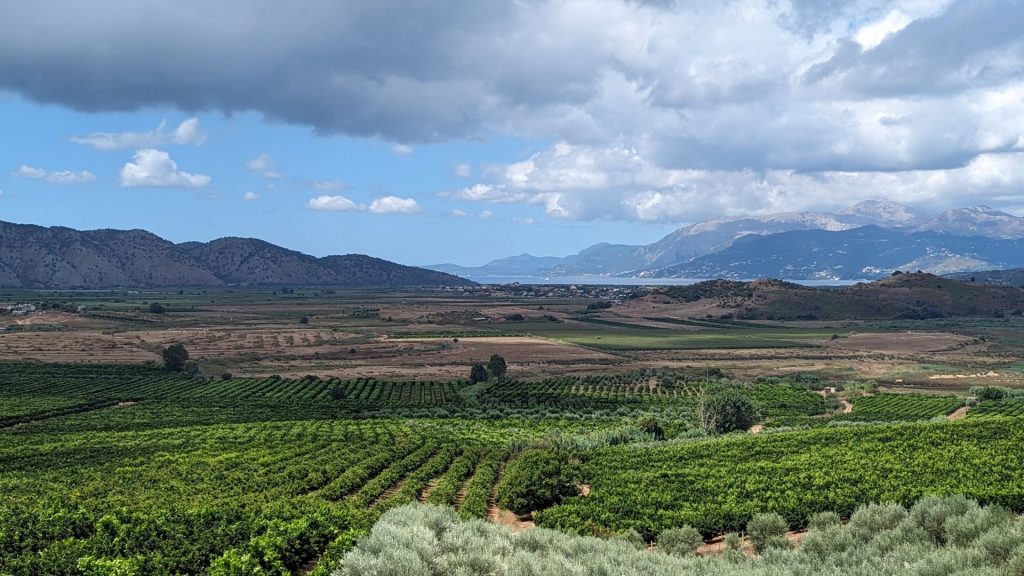
The trip started off strong with the Llogara pass. This is the highest pass in Albania, reaching 3,422ft (or 3,369, depending on the source) above sea level. The road provides some of the most spectacular views in Albania. It runs along the coast in Vlorë county. We ate at Panorama restaurant, which is at about the highest point of the pass. The scenery from the pass and the restaurant did not disappoint. Here are a few pictures:
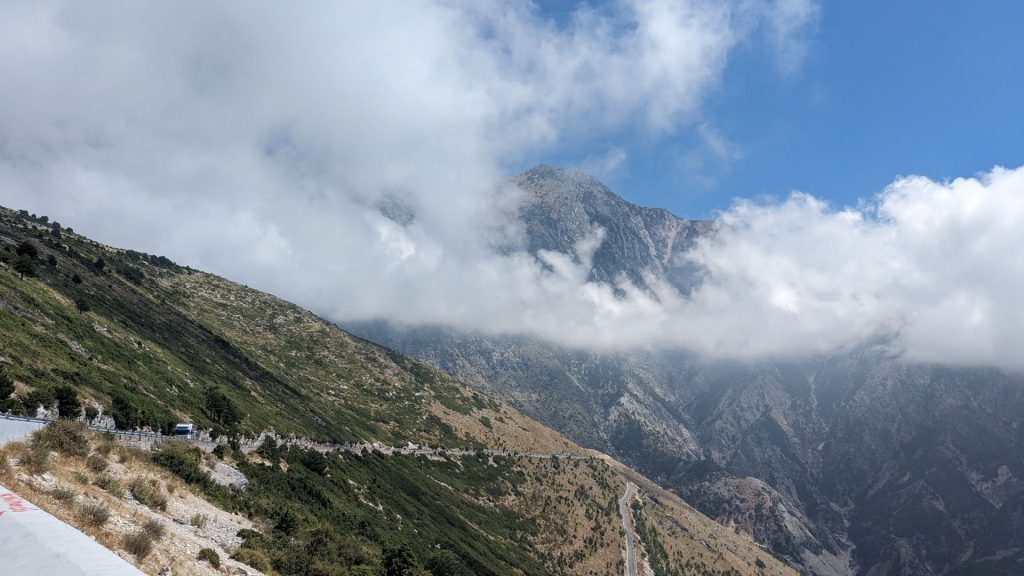
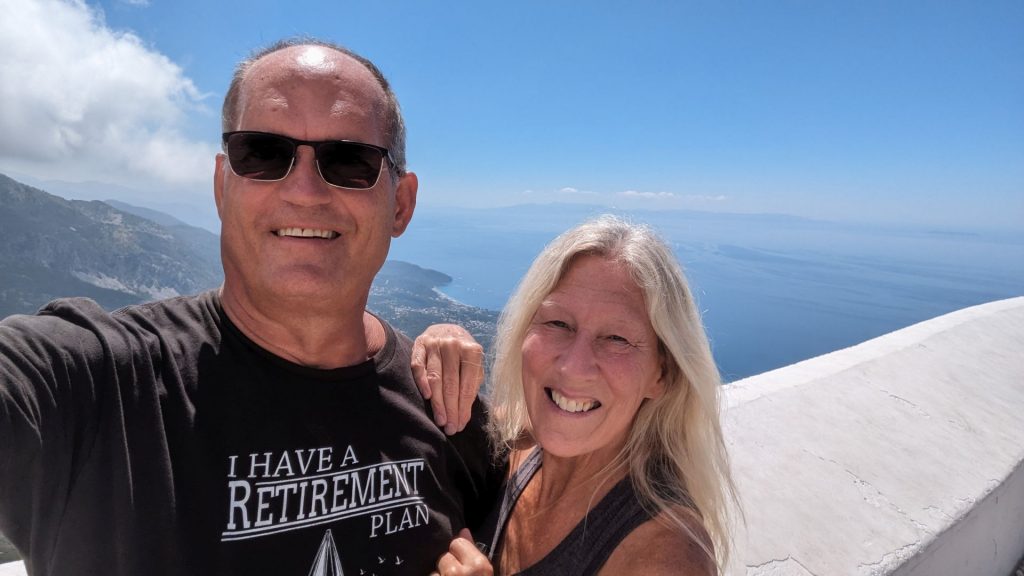
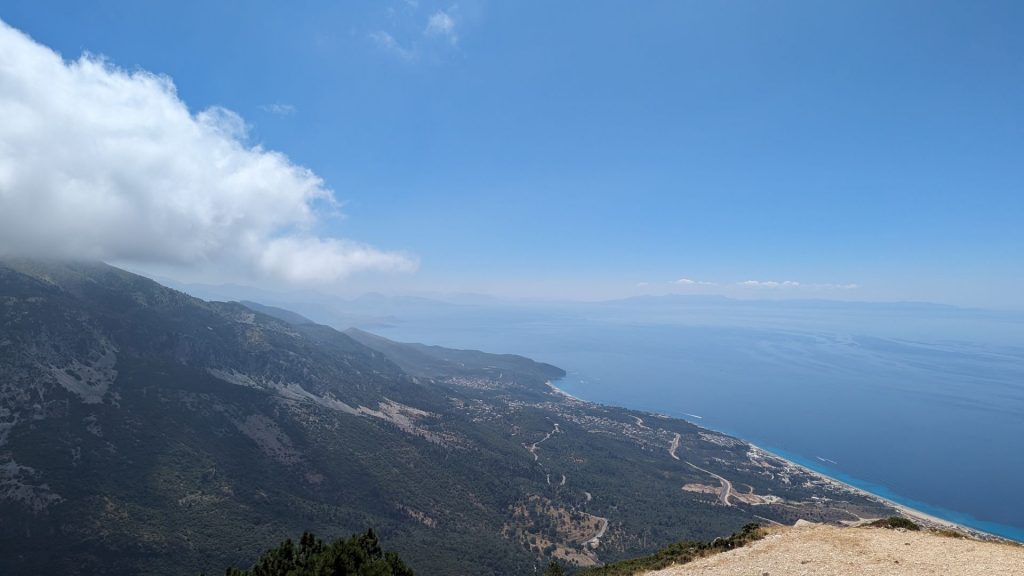
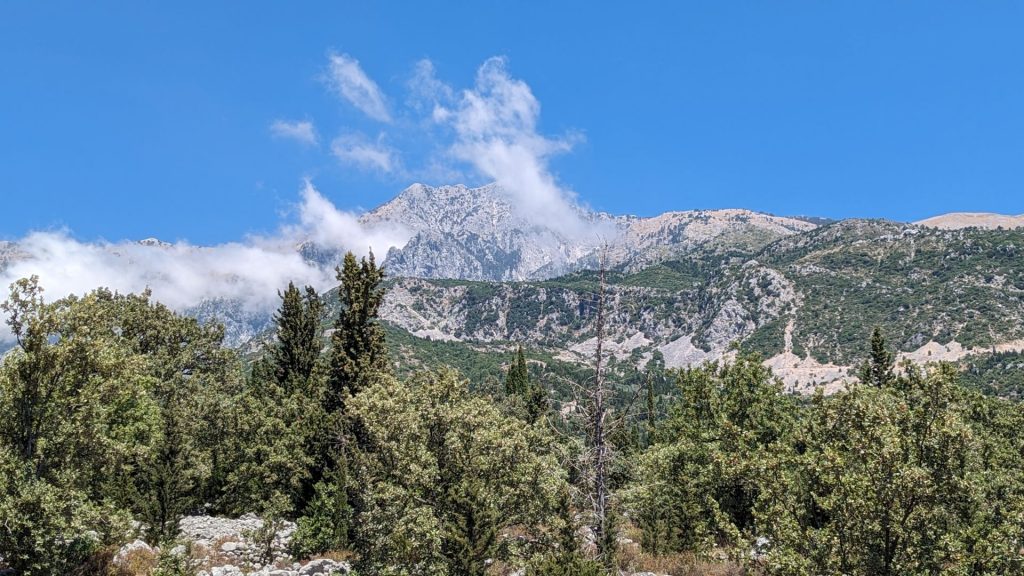
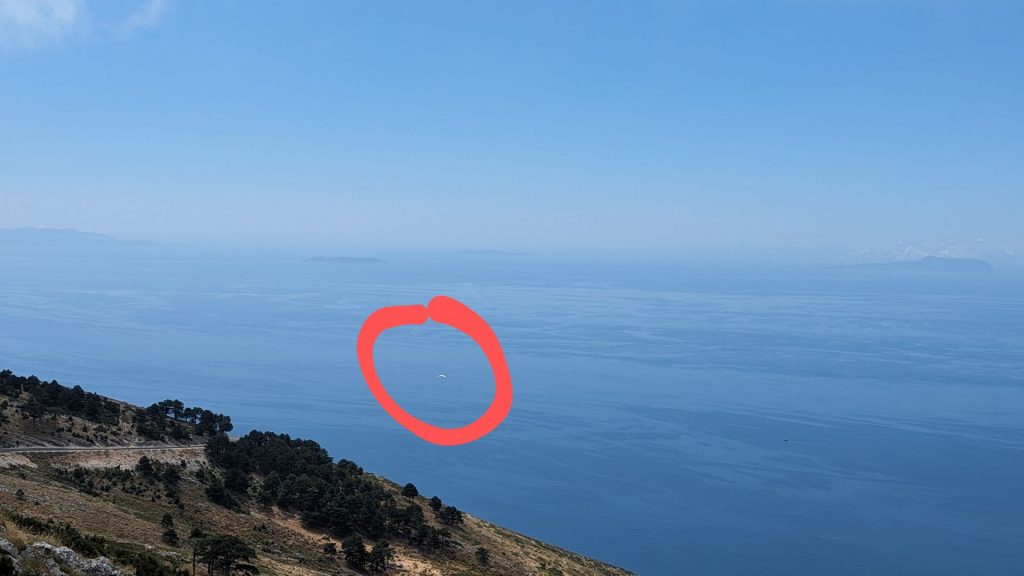
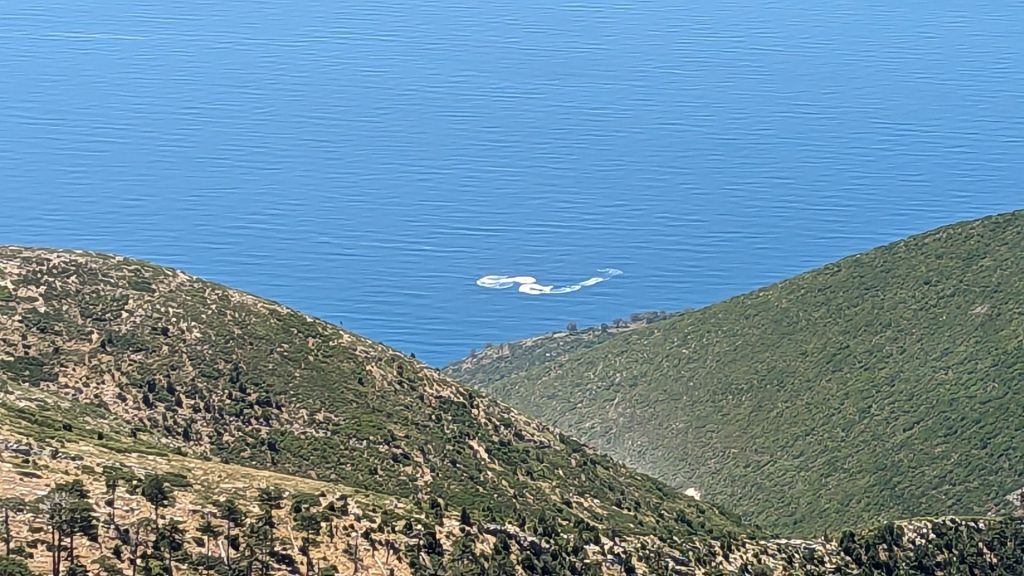
Our next stop was a beach. We chose Lamani Beach, which is a few miles south of Himarë. It was a fantastic beach and we enjoyed several hours there. The cost for two chairs was 20 euros, which wasn’t surprising on this popular beach.
The water was crystal clear. It was a hot day, so it felt SO GOOD to swim between breaks reading a book ashore. The sun kept getting higher and higher up on my body as it got lower and lower in the sky, so I ended up hooking my towel in the umbrella and hiding in the small shade it provided. 🙂
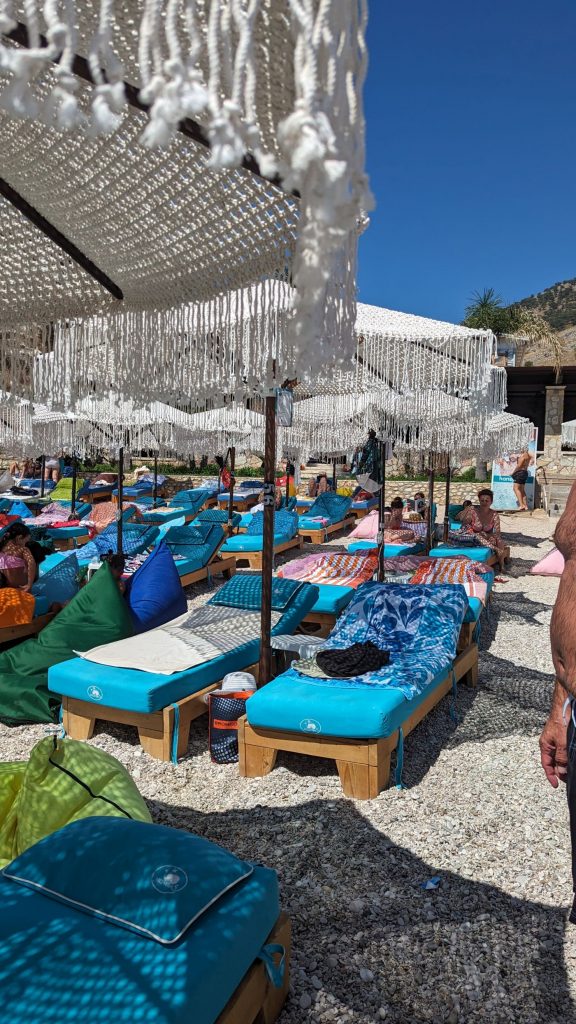
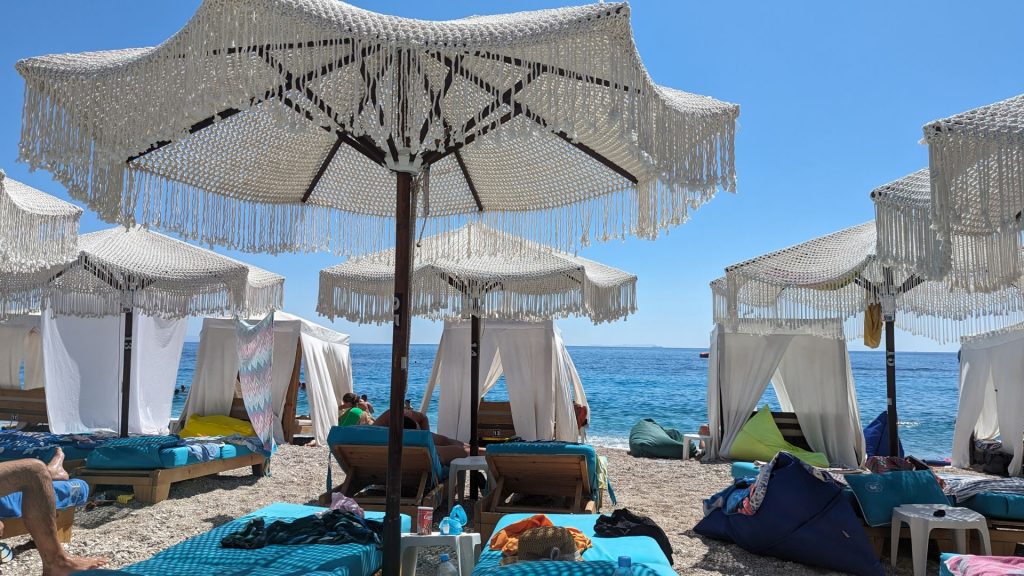
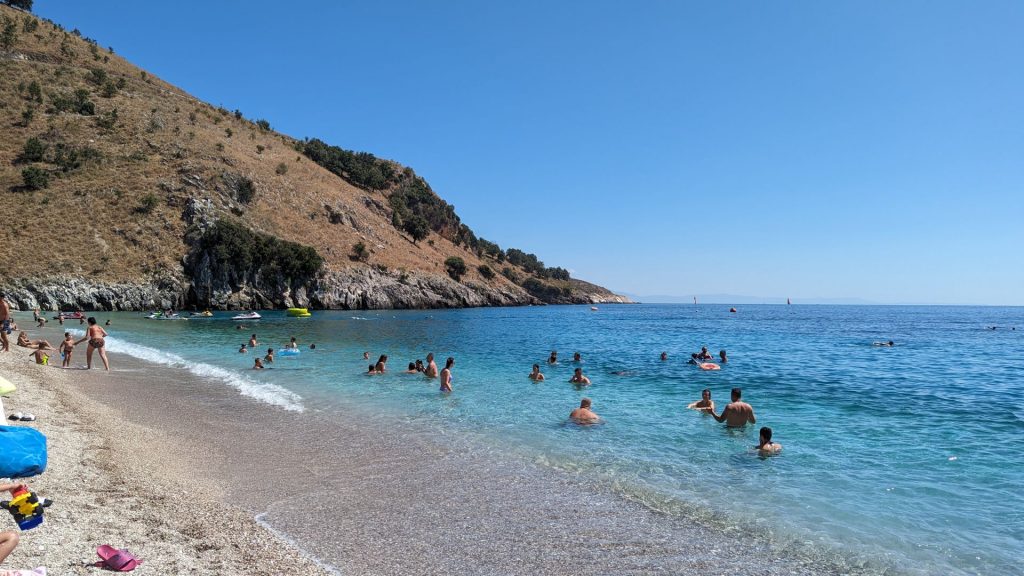
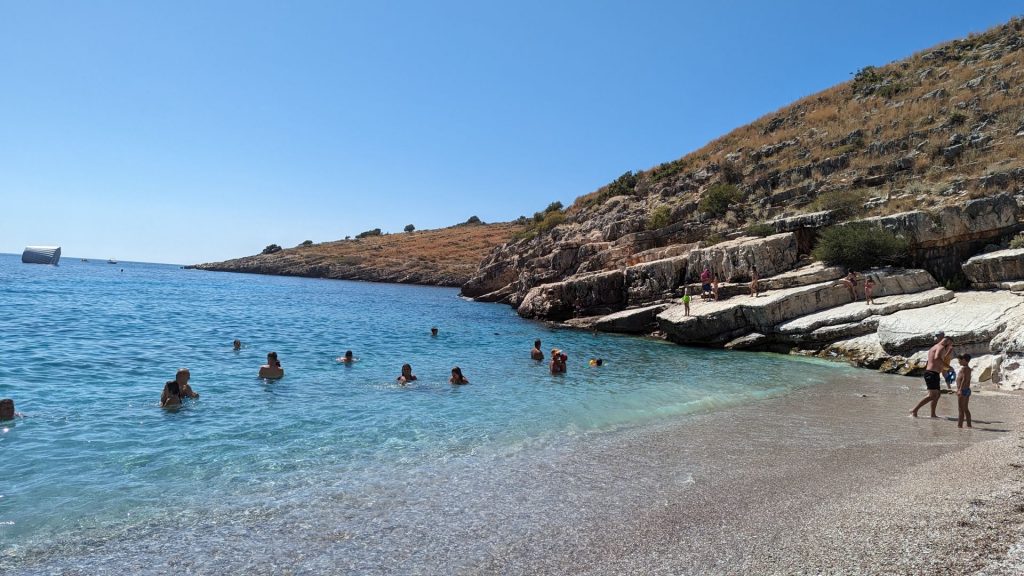
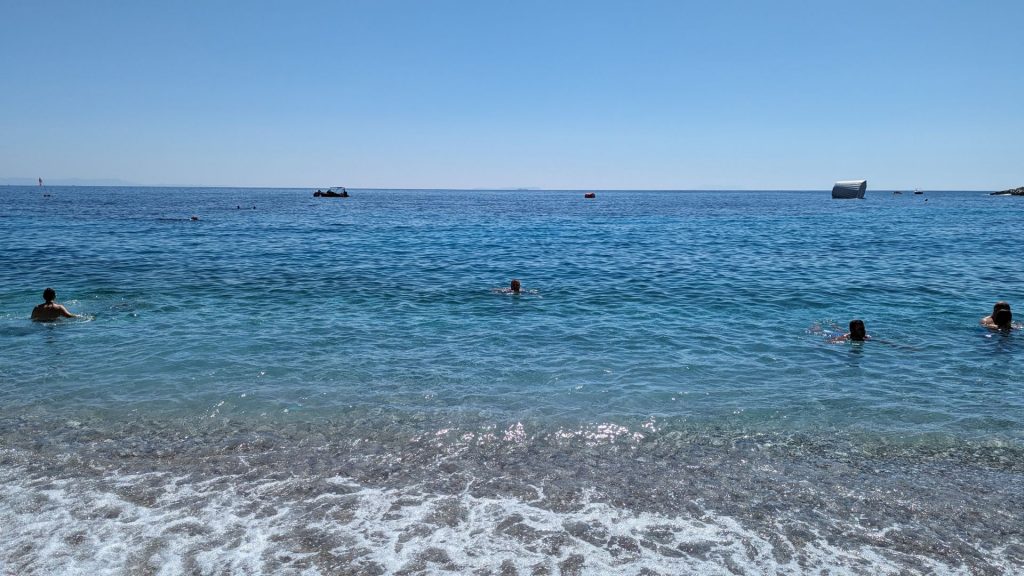
It was time to go to our hotel. But first, a little news about Albanian traffic lights. We were driving on one of the many village/town roads that is only wide enough for one-way traffic. We saw a yellow traffic light. First of all, seeing a traffic light anywhere in Albania is almost as rare as seeing a UFO; you usually just do your best to get through an intersection without hitting anyone. I figured that since it wasn’t red, it meant that I could go. Nope. A little way down the road we met several cars coming the other way (you know, right at us). The guy in the first car blinked his headlights, which is Albanian speak for, “get out of my way!” So I backed up until he and the other drivers could get through. After the way was clear, I finished the drive. Looking in the rearview mirror, I saw that their light was green. So, it would seem that green means “go” but yellow means “don’t even think about going.”
And now, a story about hotels. We book most of our hotels via expedia.com. If we can’t find a reasonably priced hotel with free parking and breakfast on expedia.com, we use Booking.com. Well we had two weird experiences (it turned out to be three, but we thought it was two) with that this trip. Shortly after I’d successfully reserved a guest house for our first night (Aug 4) on expedia.com, a person from that guest house called us and told us that an error had been made and they actually had no room for us. Shortly after that phone call, I received an email from a different hotel for which I had successfully made a reservation on expedia.com for Aug. 6 and 7, also telling me that an error had been made and they had no room for us.
So, I sent two emails to expedia.com, asking them to not charge our credit card since neither reservation actually went through (this was obviously during the planning phase, not after we’d started our trip). A gentleman from expedia called us that night, assuring us that it would be taken care of, but he was only focusing on the first cancellation. I told him about the second, and he told me he would escalate the case for that one.
In the meantime, I made another reservation myself for the first night through Booking.com because I couldn’t find another reasonably priced one on expedia.com.
Back to where we were in the story. . . . So, we showed up at ELEA Guesthouse (the second reservation I’d made for the first night) and the woman met us and told us – surprise! – that an error had been made and they had no room for us. BUT, this woman was an angel and she had already found another place for us to stay (Blue Sky Rooms). She also invited us to eat a free breakfast in their restaurant the next day. She also invited us there for dinner that night.
We followed her in her car the very short distance to Blue Sky Rooms. The room and view were lovely! See for yourself.
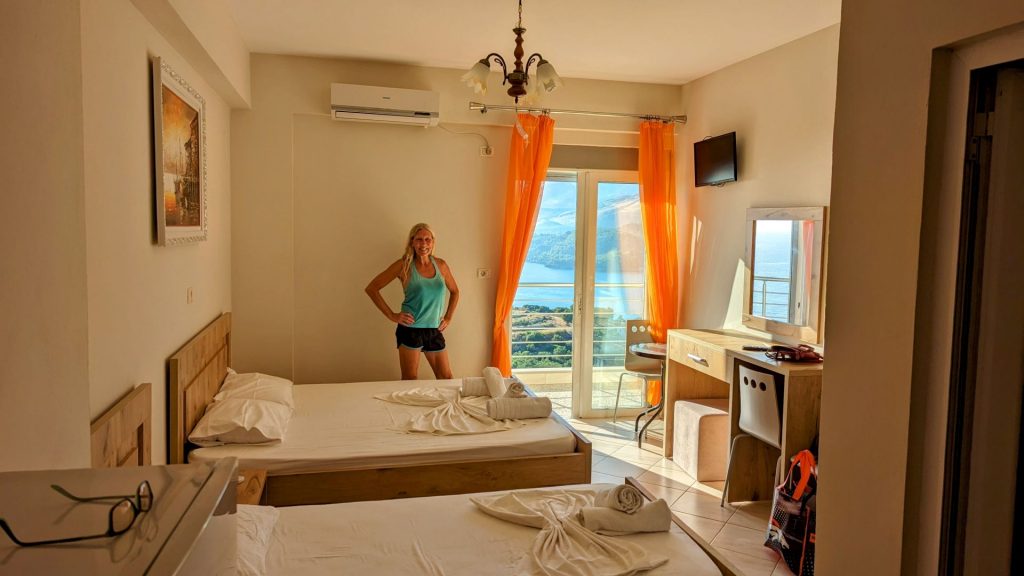
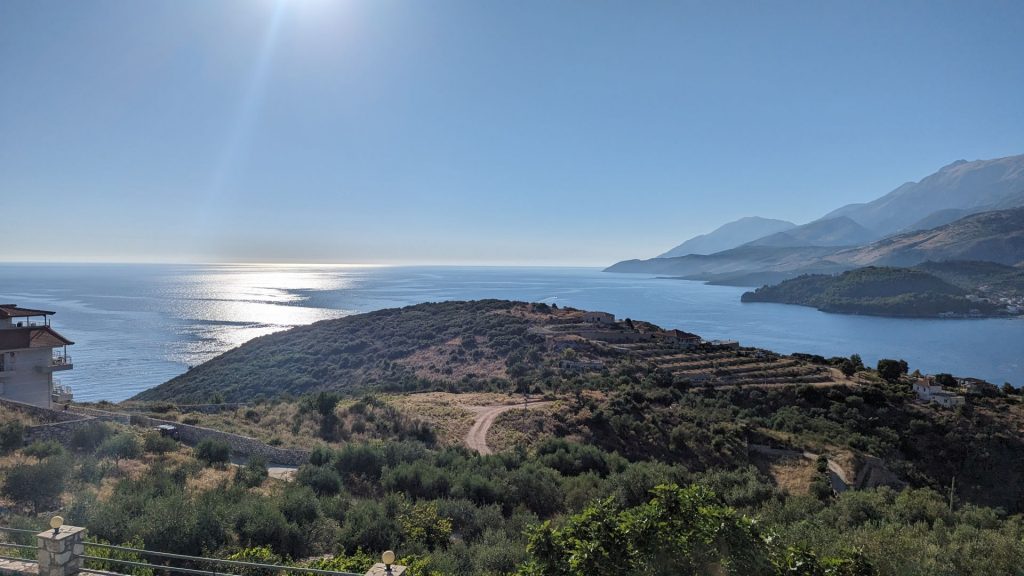
We ate both dinner and breakfast at the ELEA Guesthouse. ELEA Guesthouse is a family run business (there are three generations but the folks in the third one are quite young – or not born yet but getting big- and probably not helping run the joint), and it is lovely.
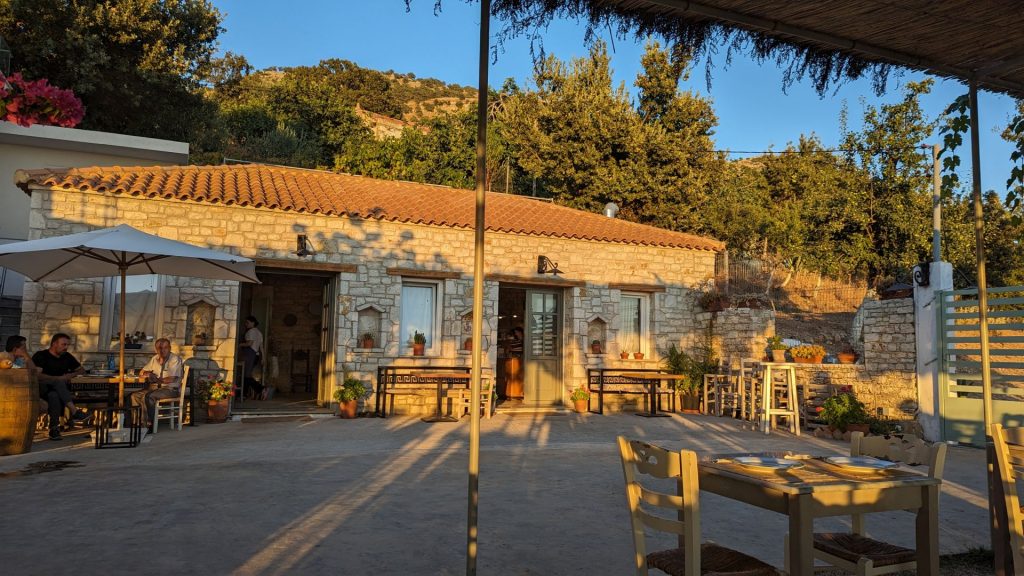
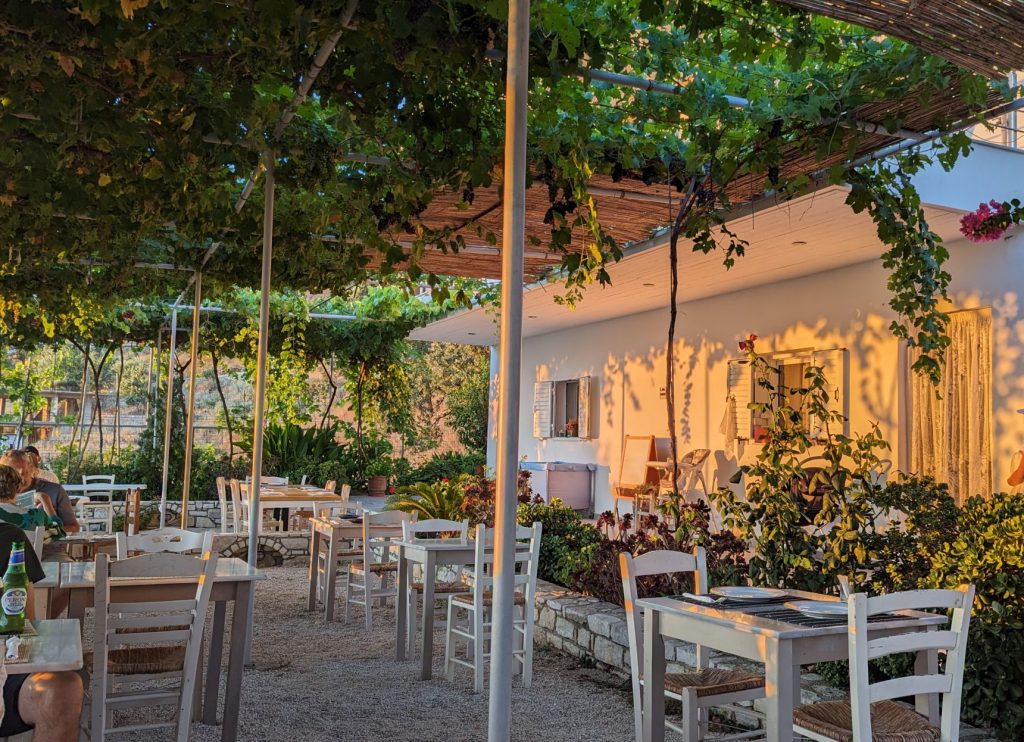
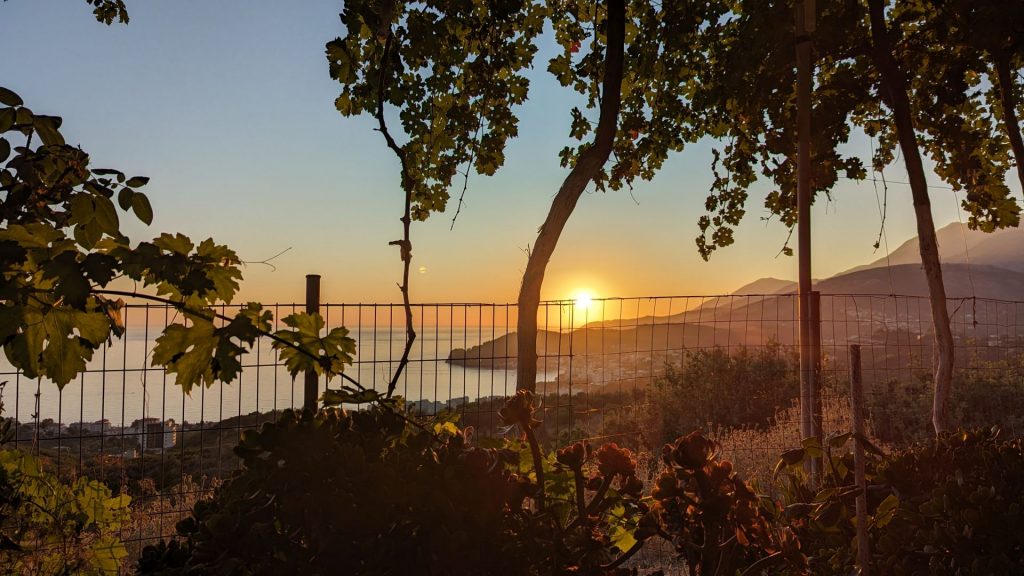
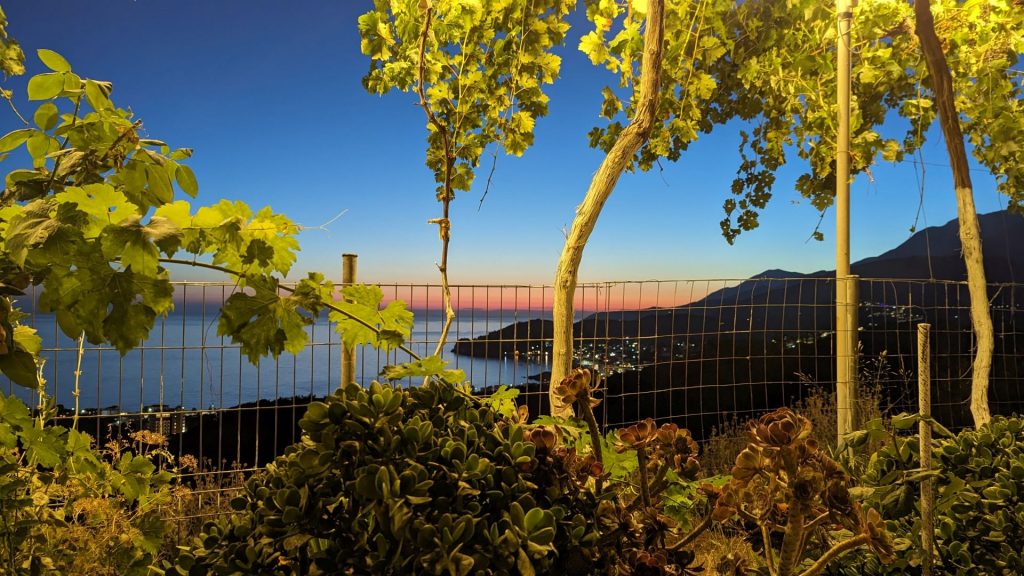
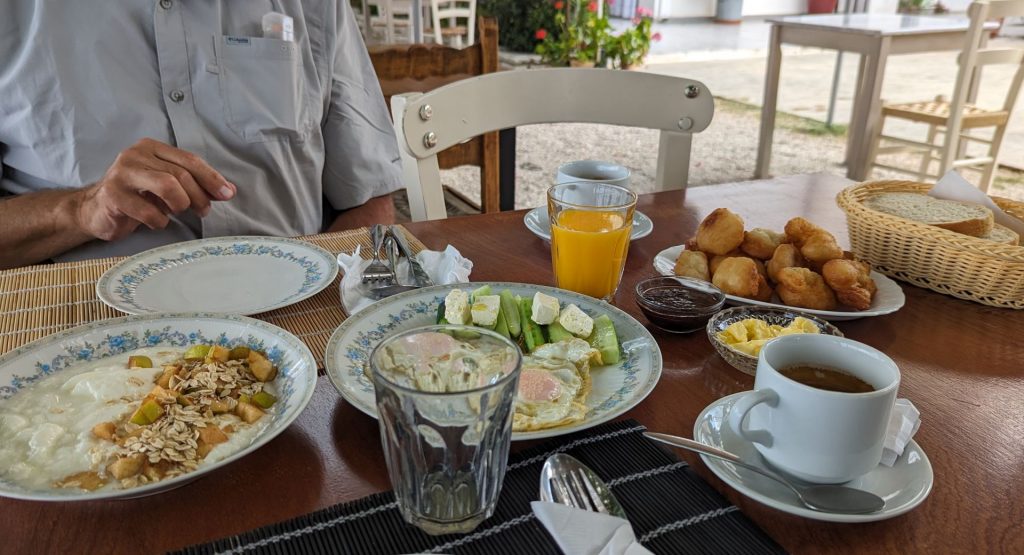
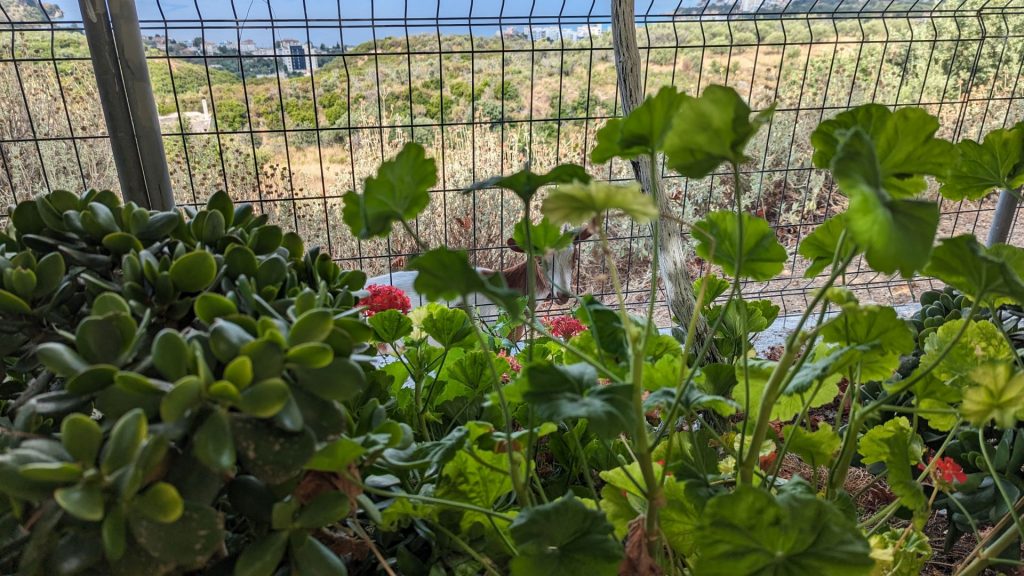
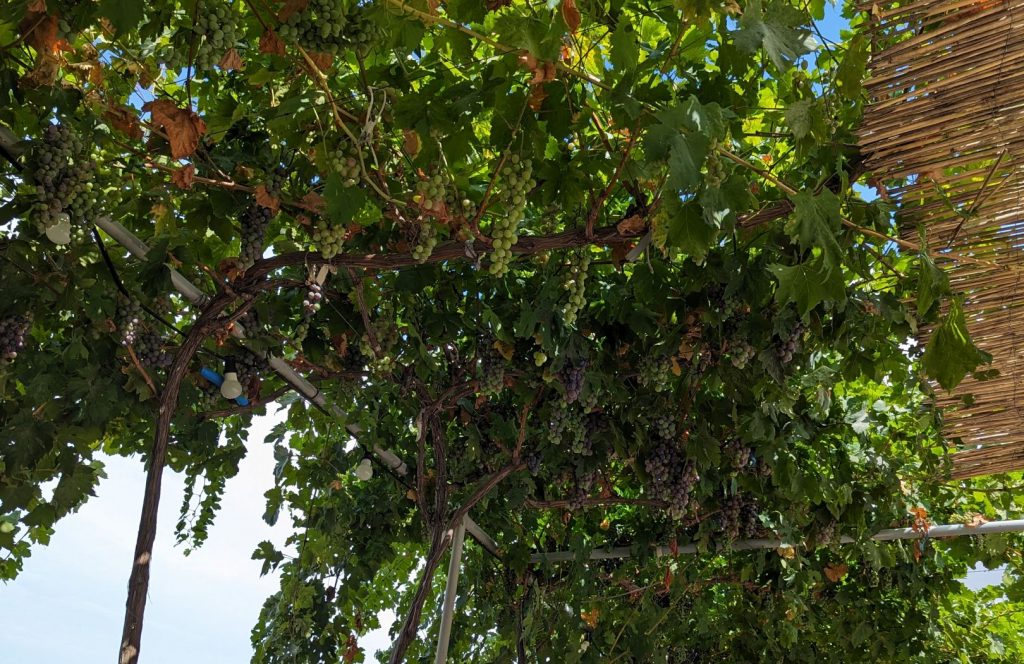
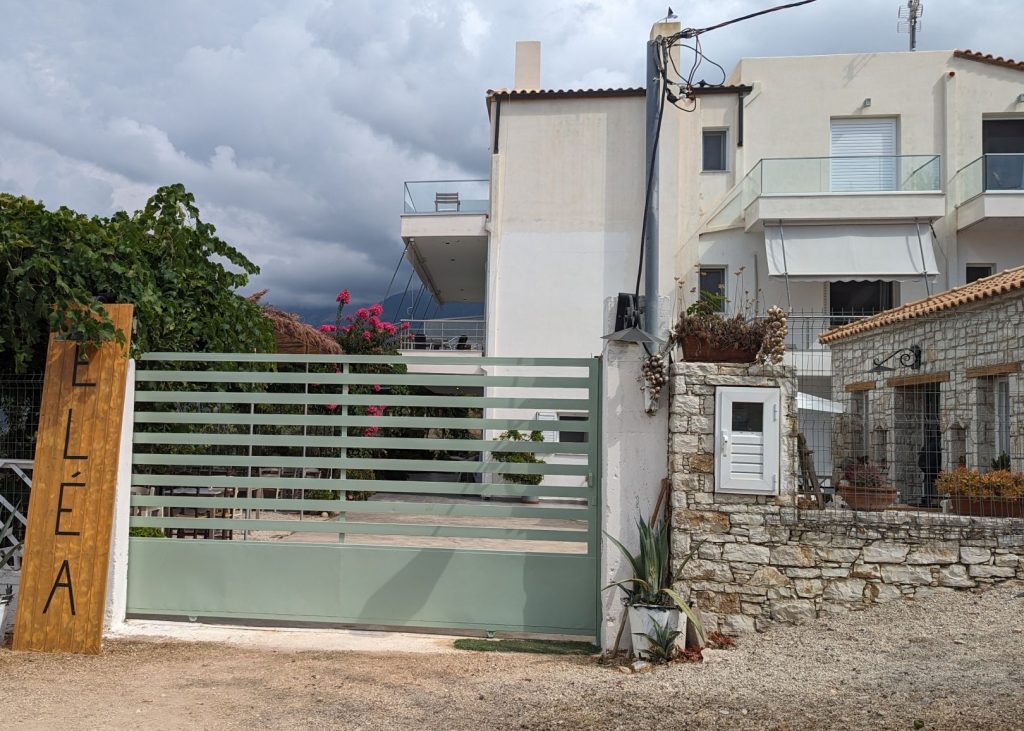
They have to keep the gate closed to keep the goats and sheep out. 🙂 They would eat everything if they came inside – at least the goats would.
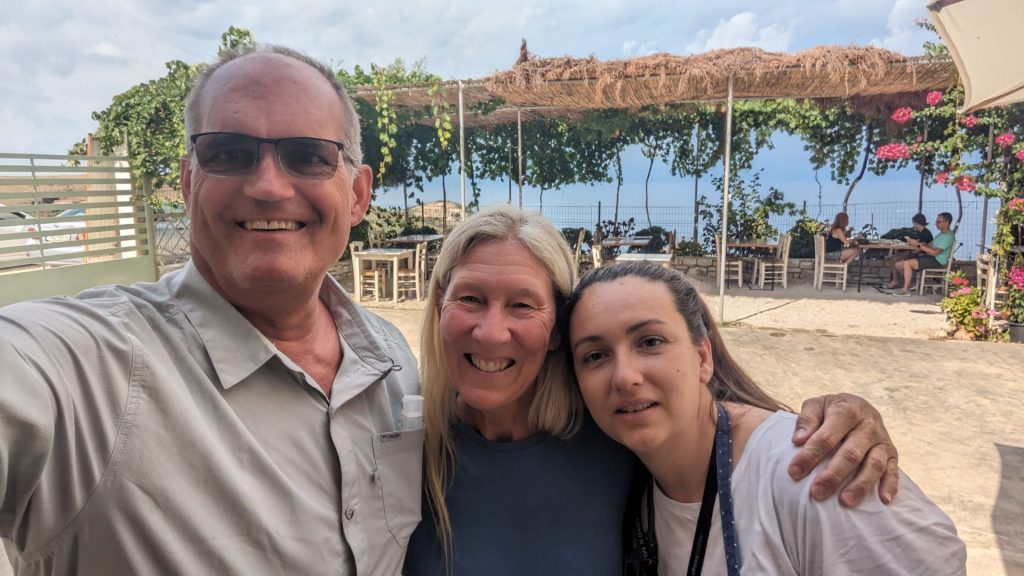
Day Two: Rain was forecast for this day so our goal was to get in our sightseeing in the morning before the rain started. It was supposed to be more of a downpour than a sprinkle. We succeeded.
Before we get into the day, I want to share this picture with you. We saw so many rows of trees on the hills just like this. It is clear that the trees were planted by humans.
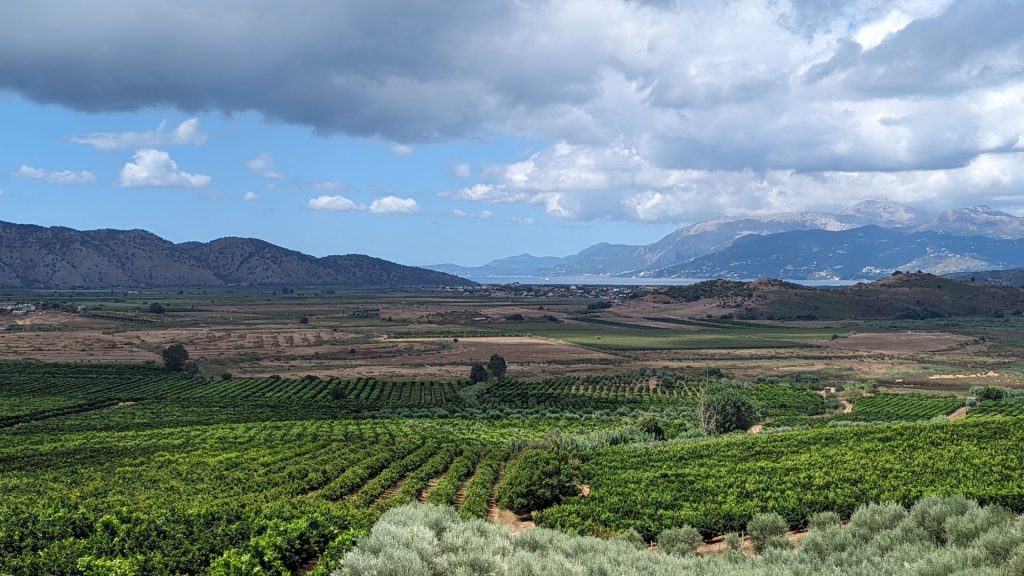
Our first stop was Porto Palermo Castle. This was recommended by one of the gentlemen we met at Orikum Marina. We are so glad he did! Here is a bit of information from a combination of sources. I find it to be of interest, especially the controversy over when it was built.
Porto Palermo Castle is situated in the closed bay of Porto Palermo, a few kilometers south of Himarë, and makes nearly an island that is connected to the mainland by a narrow strip of land. In the ancient world, the bay of Porto Palermo has always been an important harbor which had to protect Himarë. In Greek it was named Panormos (Panorama), and later renamed to Porto Palermo in the Byzantine era.
People can visit every room in the castle. The castle has a triangular shape with three pentagonal towers at the corners, which are built out of limestone. The walls are made of regularly set stone blocks and are between 3.2 and 3.5 meters thick. Centrally located on the ground floor is the prison. Guards used to patrol the several passageways. A stone stairway leads to a terrace on top of the castle. There are five survey towers which have gun loopholes and are covered with domes. The views of the Ionian Sea, the rocky coastline and the mountains from the castle terrace are amazing.
During and after World War II the castle has been used as a prison and a shelter for military units. In 1948 Porto Palermo Castle was declared a ‘Cultural Monument’ and nowadays serves as a museum.
The fort served as former Soviet submarine base during the communist regime in Albania, and nowadays its semi abandoned tunnel and barrack attract attention of visitors, as well as the stronghold walls and gates built by the powerful Ali Pasha of Ioannina (see more about Ali Pasha below).
The Ottomans made several attempts to take over the area from the Venetians and use it as a platform from which to attack Corfu, when at the end of the 18th century, Ali Pasha succeeded to swiftly conquer and claim rule over the former Venetian positions during his reign whose influence has proved enduring to this day. In 1803 Ali Pasha offered the castle and port to the Royal Navy at which time the fort only had four or five cannon, implying that Ali Pasha did not see the fort as an important defensive system.
The well preserved castle is asserted by guidebooks and the local tourist guides, to have been built in the early 19th century by Ali Pasha of Tepelena, but most probably it was built earlier by the Venetians as it has the same triangular plan with round towers found on the Venetian fort at Butrint. (We visited Butrint and will share more about that later.) In 1921 the castle was called Venetian. At this time the identity of its builders ought to have been clear from a plaque above the entrance gate, which is now missing, but the weathering of the stones clearly shows that it had not been missing for many decades. Almost certainly this plaque had a carving of the lion of St. Mark. The castle would also have been vulnerable to cannon fire from the hill above and this also suggests an early date for its construction when cannon had not developed the range they had later. The most plausible explanation of the error found in the guidebooks is a rewriting of the history in the communist period.

This is the only picture I have from “above” and it was taken quite far away. You can see the road from the mainland to the “almost island.”
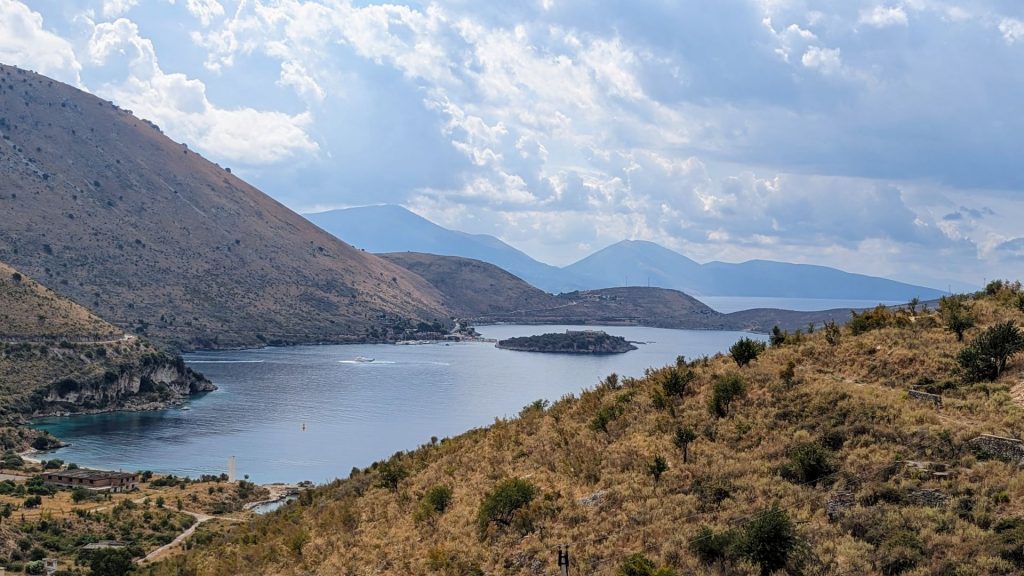
Here are our pictures from inside the castle and from the terrace. We don’t know why they use color in the rooms, but we like it!
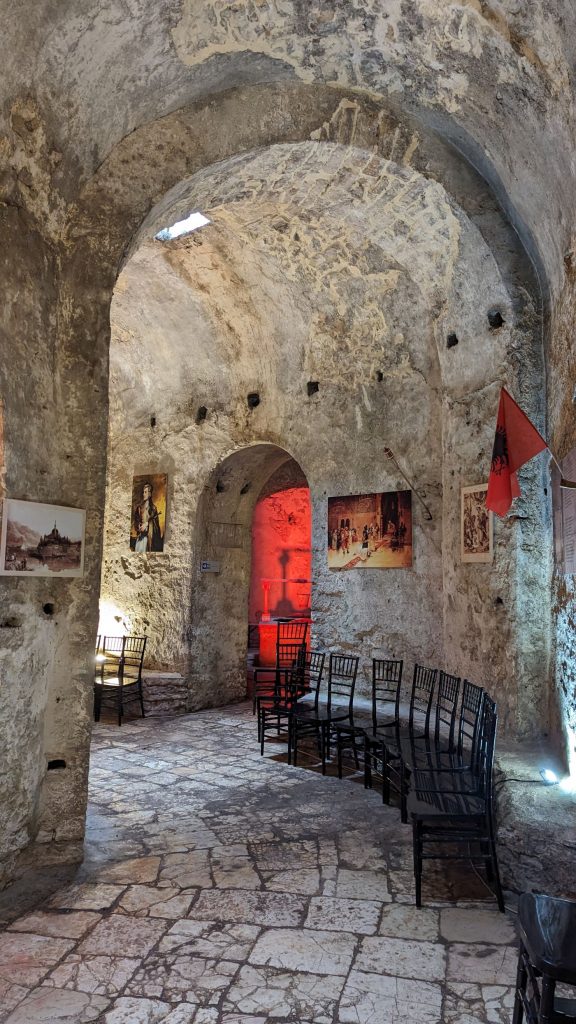
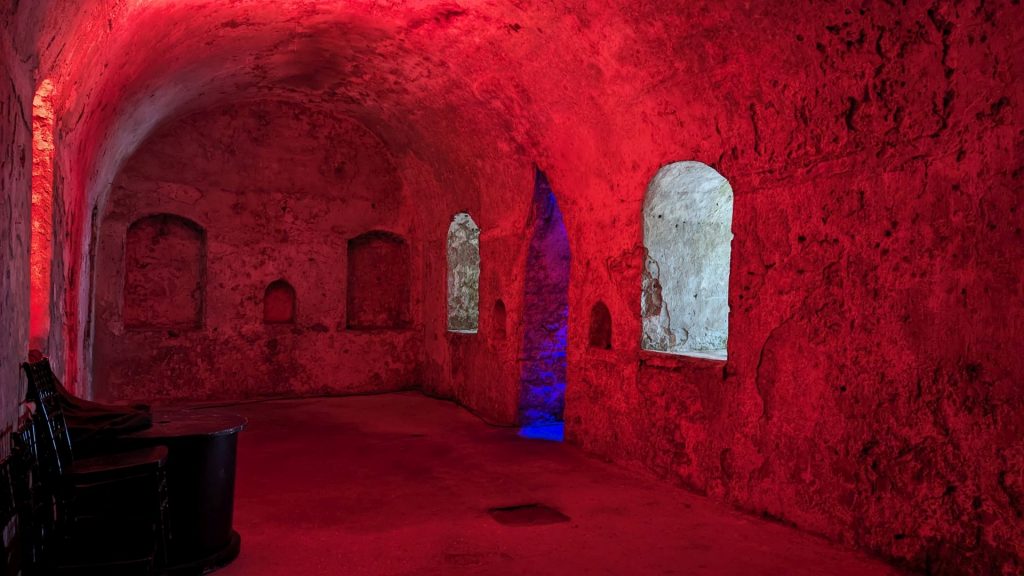
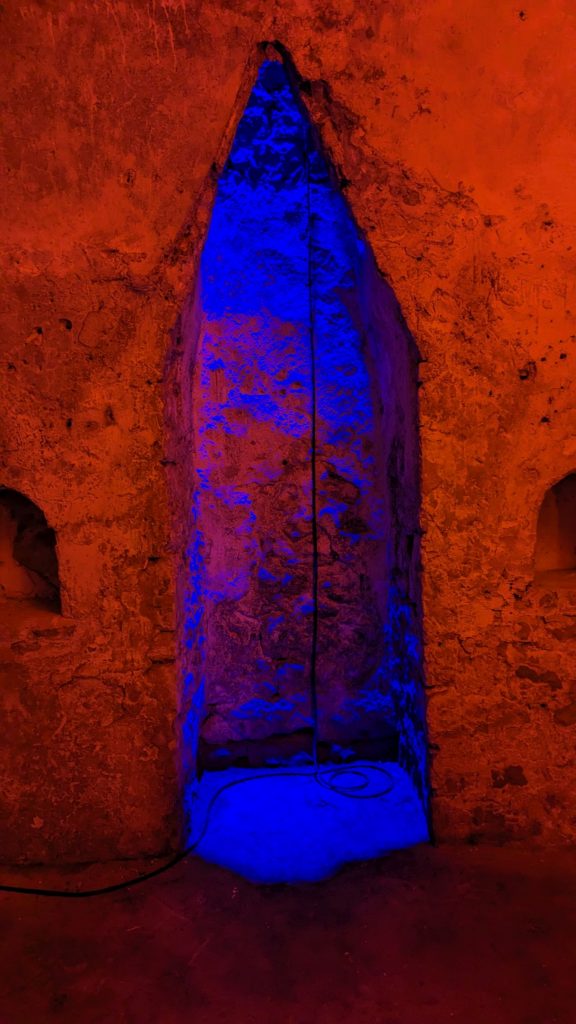
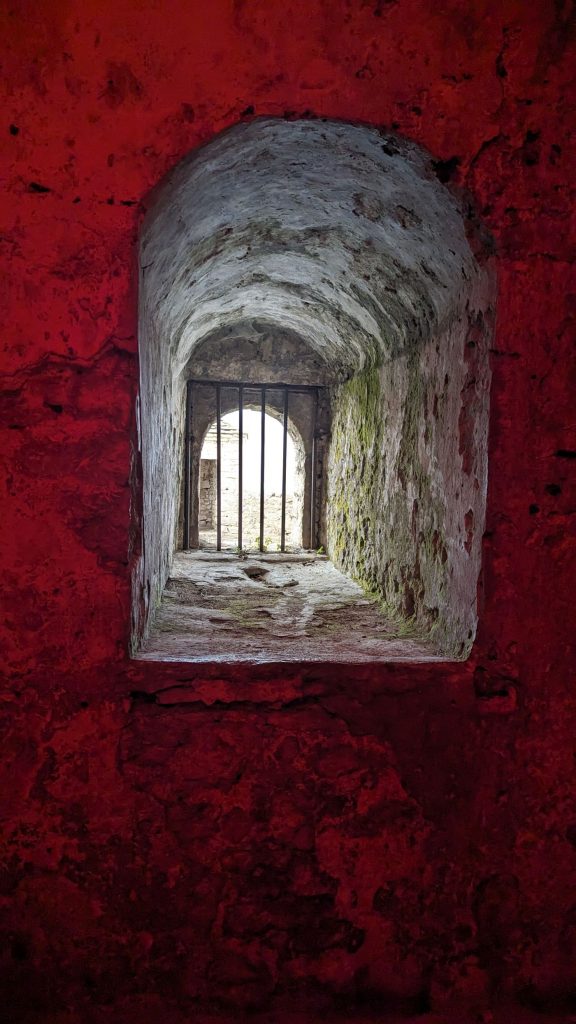
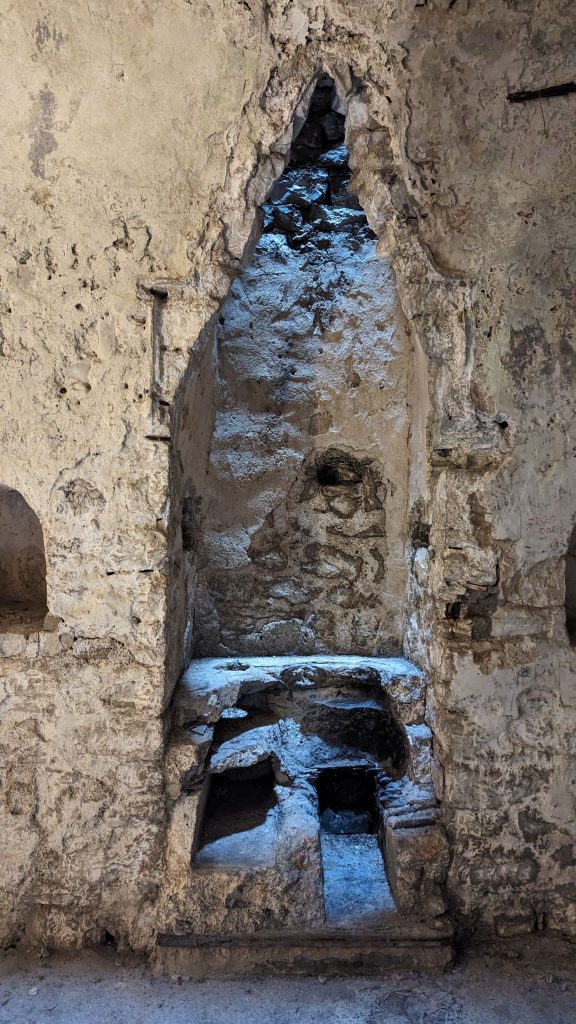
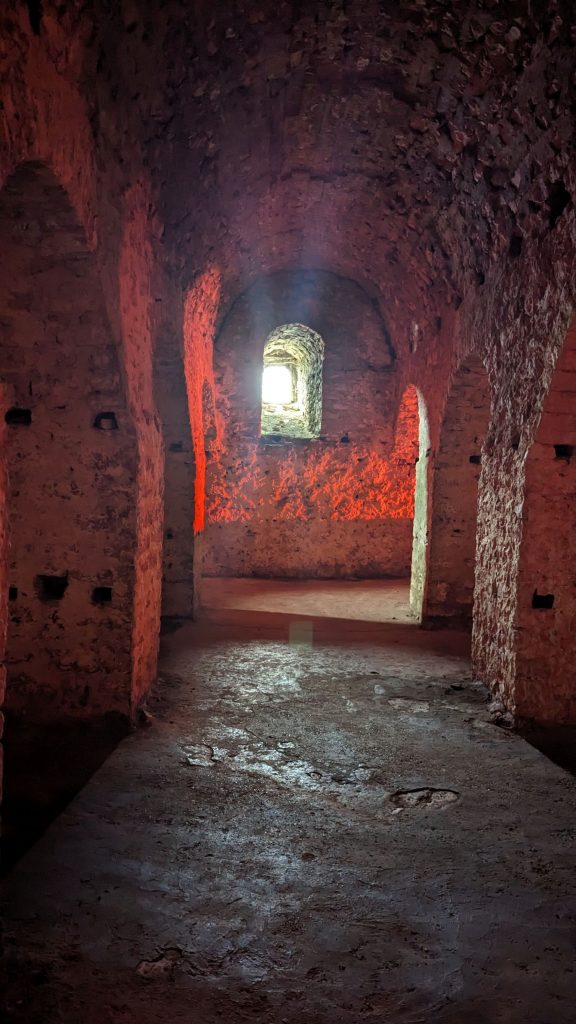
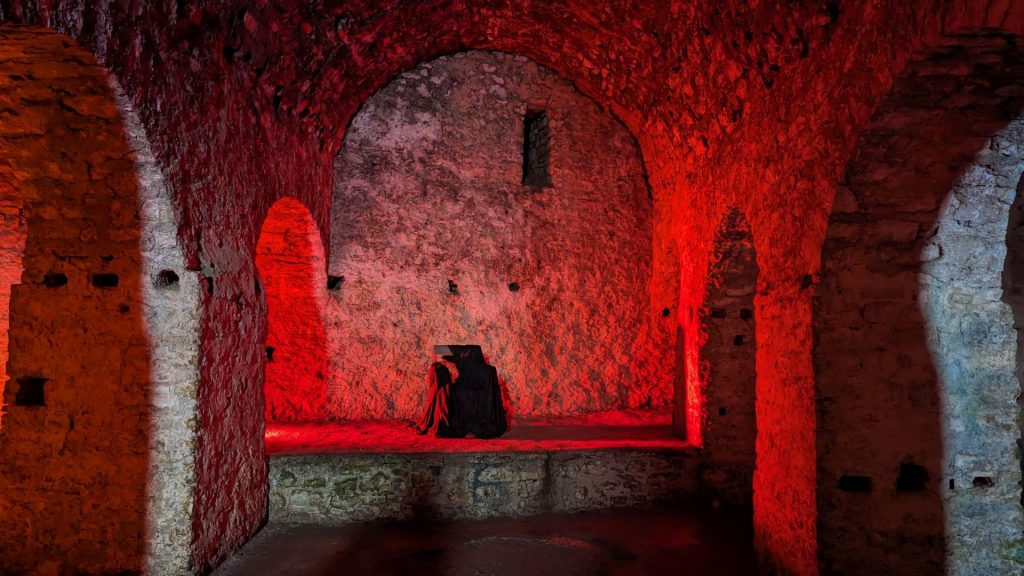
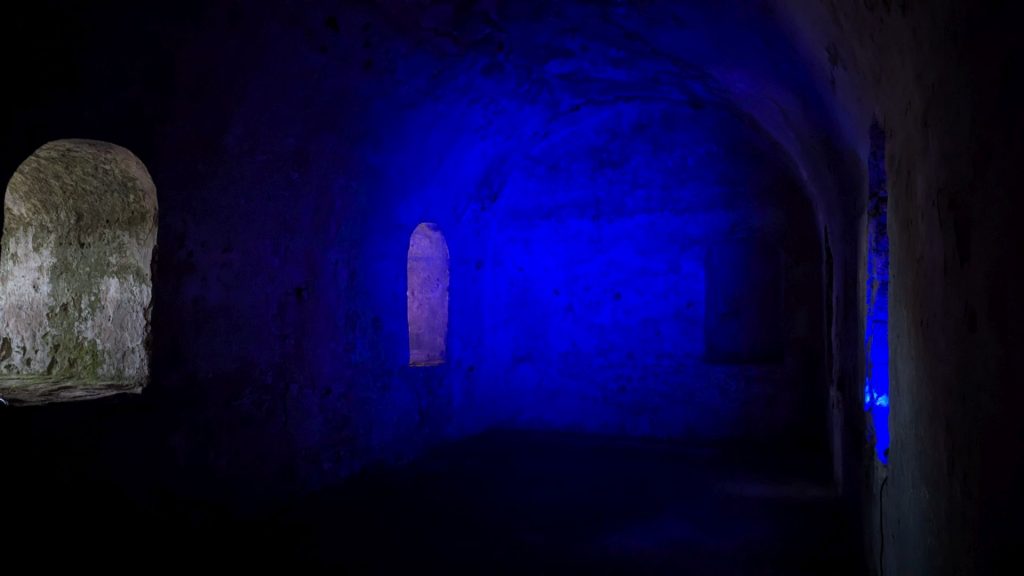
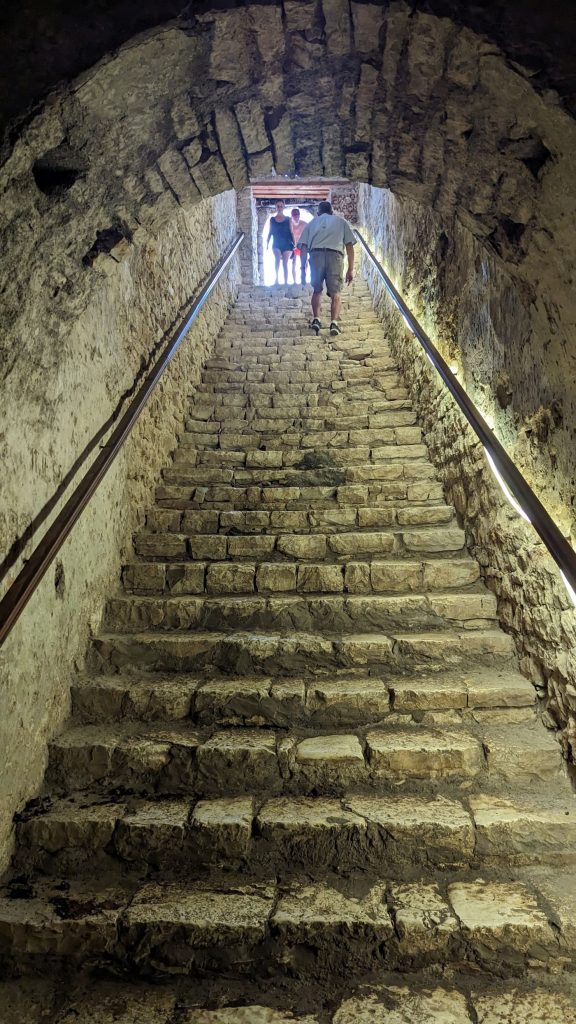
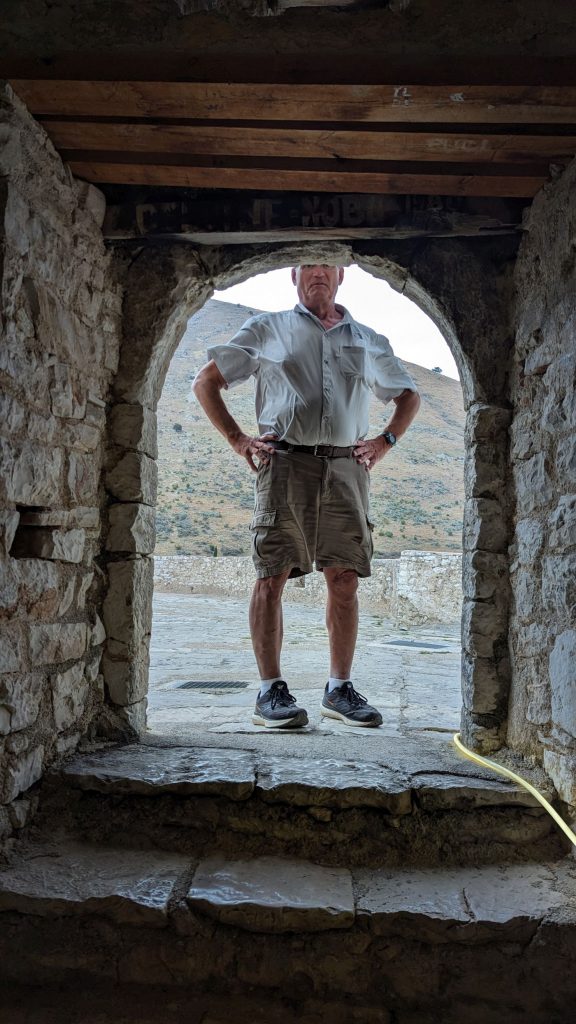
As you view the pictures from up top, I hope you will enjoy the dramatic skies as much as we did. The storm didn’t appear to be too far off at this point, but it was still quite some time before it started to rain.
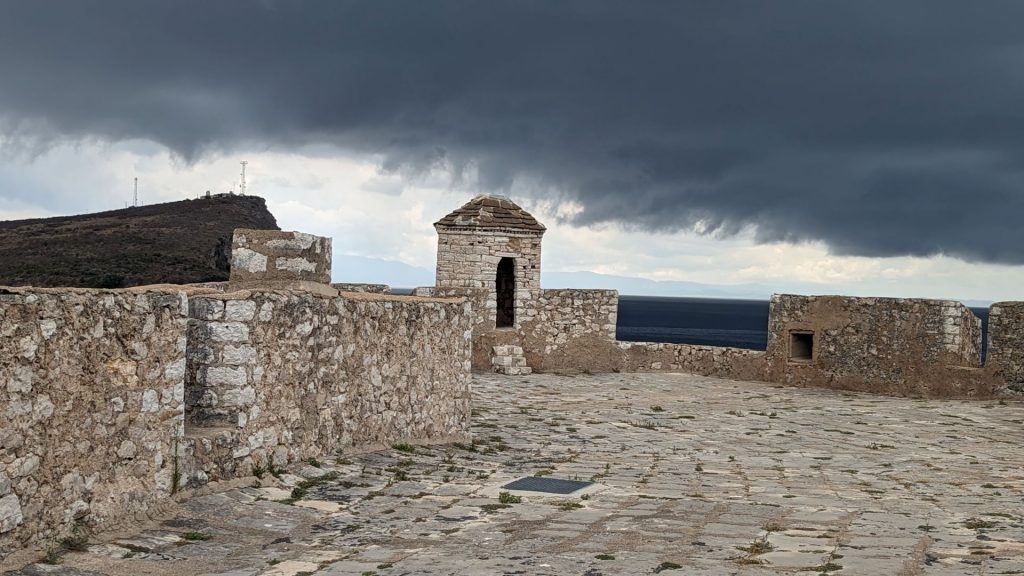
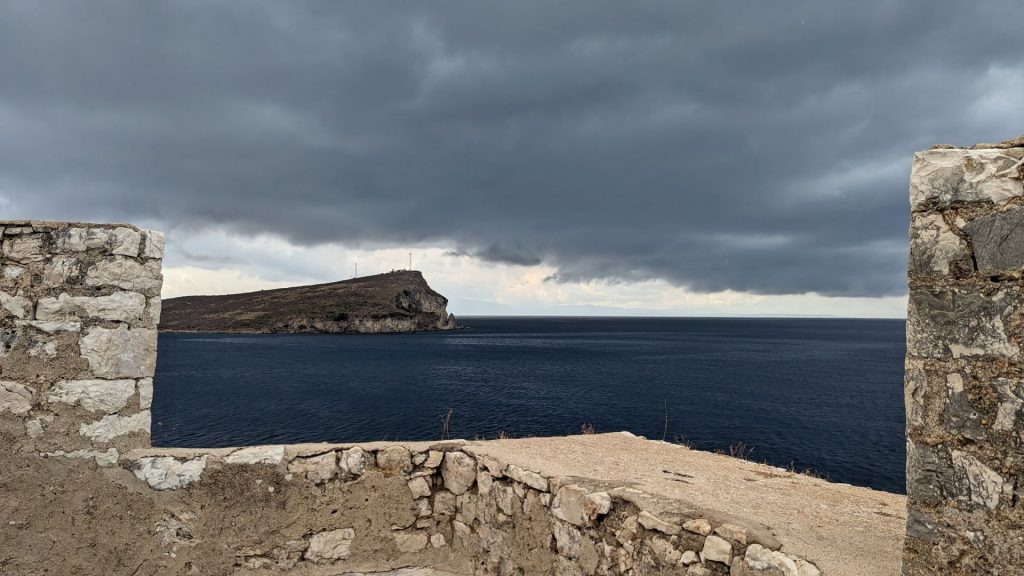
After our fill of the castle (we didn’t rush), we headed to The 40 Saints Monastery. The wind was really picking up by this time, but still no precipitation. Again, a little background information combined from various sources to help you appreciate this place.
The monastery was built in the 6th century A.D. as an important Byzantine pilgrimage site. A number of dedicatory Greek inscriptions made of broken tile and potsherds have been unearthed on the sides of the structure with some of them dating from the 5th and 6th centuries. The monastery may be one of the only monuments of its kind in Albania and the Balkans. Declared a cultural monument of the first category in 1970, the monastery is located only a few kilometers from Sarandë. The site is not only a must see for its history, but also for its location and views over the Sarandë bay on one side, and the mountains on the other side.
The complex of the monastery included the basilica church as well as hostels for pilgrims and other guests, underground chambers, holy water springs and crypts. In the underground rooms there were a total of forty small chapels, each dedicated to one of the Forty Martyrs of Sebaste (see the legend below) who were martyred during the Early Christian period.
The iconostasis of the church consists of a row of columns over which extends an elegantly decorated epistyle, while the stones in the bottom are all decorated throughout. Murals of Byzantine disciples adorn the walls of the monastery with one of them thought to be the oldest Byzantine mural in Albania. From the two symmetrical rows of windows, visitors can have a gorgeous view of the city below.
The monastery remained a major pilgrimage site until the 14th-15th centuries when it suffered repeated destruction due to the Ottoman conquest of the region. However, it again attracted renewed attention in the 18th-19th centuries. The basilica was abandoned and fell into ruins in the early 20th century, but part of its high walls were still standing as seen in photographs dating from the early 1930s. The roofless church remained a place of annual religious celebrations on each 9 March. Additionally, a small number of monks appear to have been active that time there.
During World War II (1944) the monument witnessed devastating destruction and was reduced to shattered ruins: it was either destroyed by German artillery or Allied aircraft. In the 1950s it was demolished during the atheistic campaign launched by the authorities of the People’s Republic of Albania. The site was transformed into a military base, a fact that prevented the preservation of the monument. It remained as such until the Albanian Civil War in 1997.
During the High Middle Ages the name of the monastery was transferred to the nearby coastal city of Onchesmos. It developed into the modern settlement of Sarandë. As such, the monastery has played an important role in the history of Sarandë. Agi Sarandë, means “Forty Saints” in Greek. Later the name was shortened by removing “Agi” and only keeping Sarandë (forty).
Much of the massive structure of the basilica has long been demolished today with only parts of its side walls still standing. However, it still retains some religious importance for the local Greek Orthodox population and pilgrims continue to leave flowers there. The ruins of the monastery lie across from the bay where Lëkurësi Castle stands.
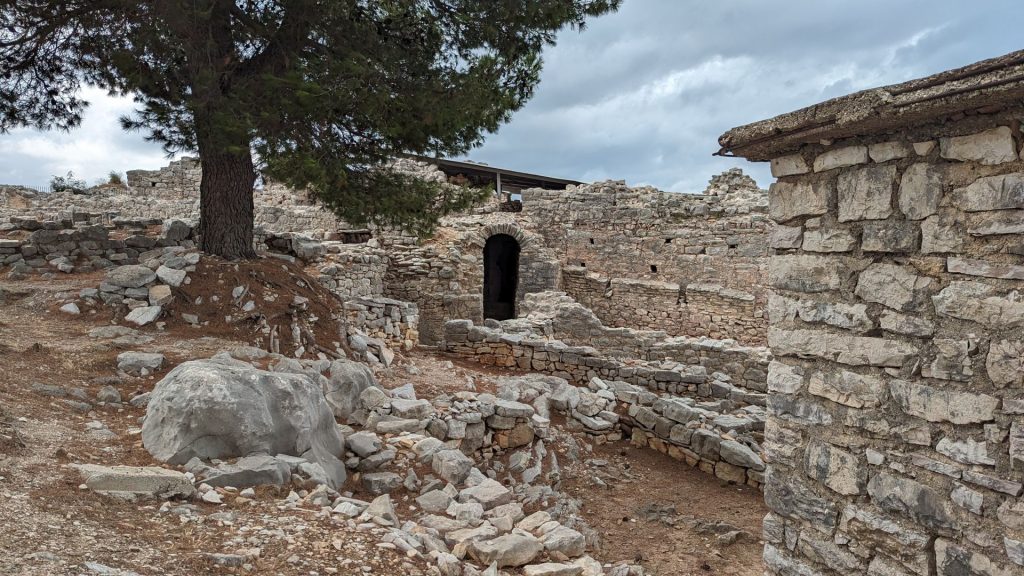
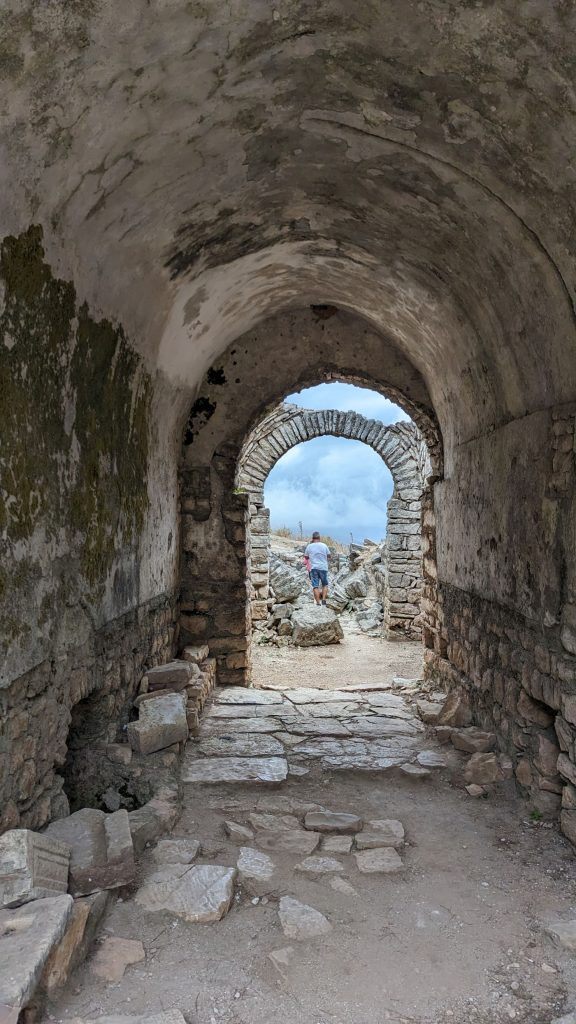
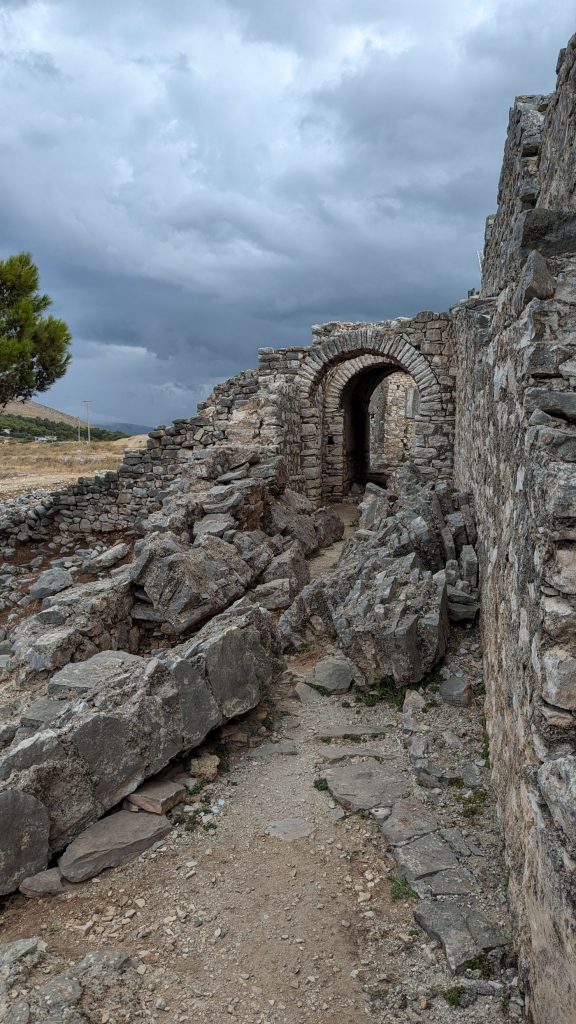
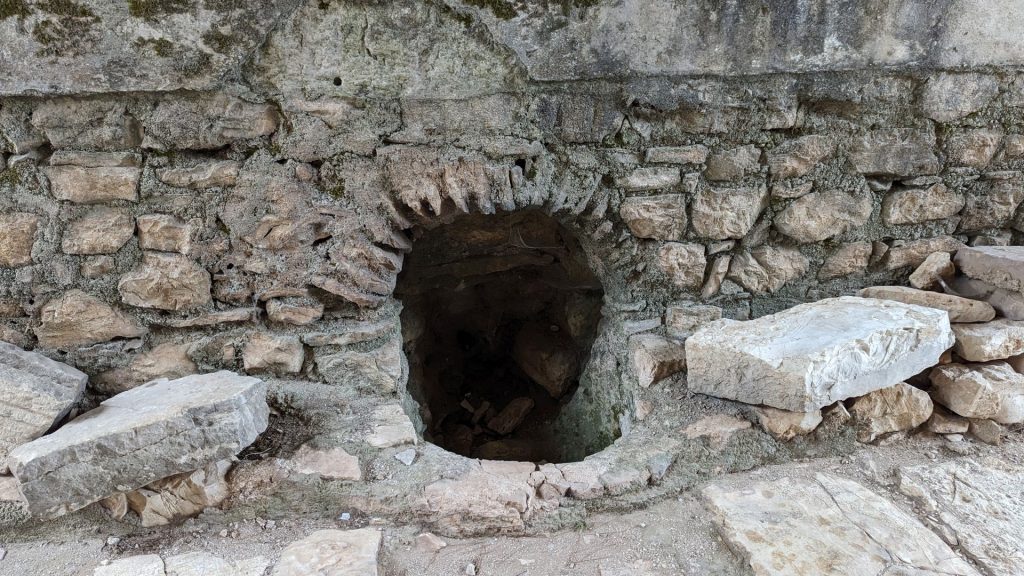
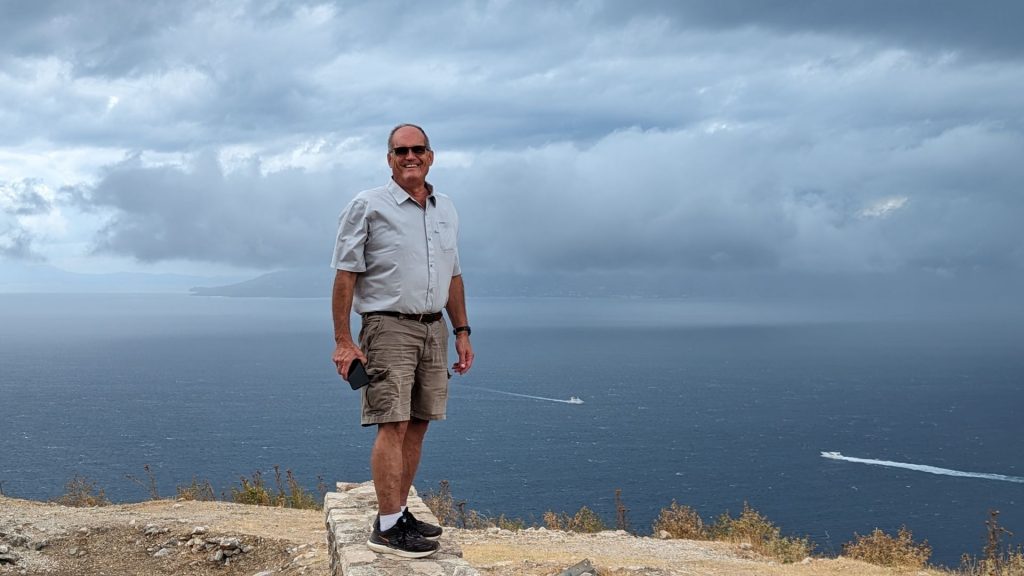
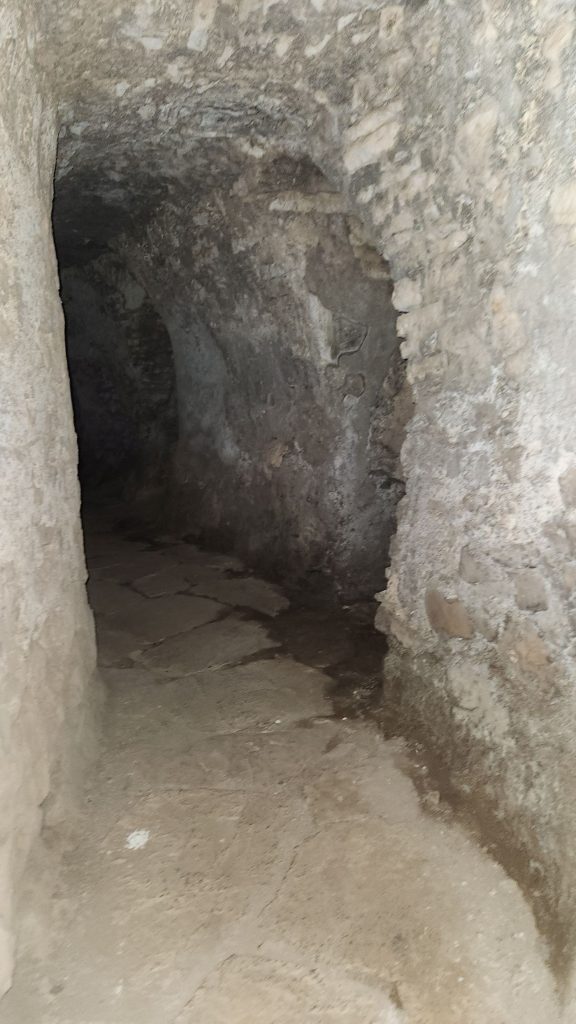
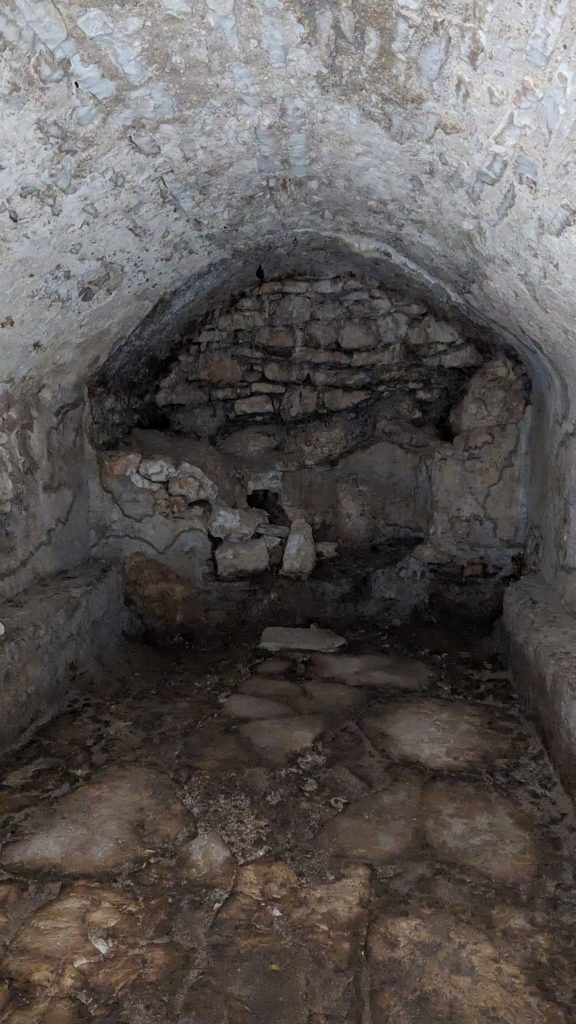
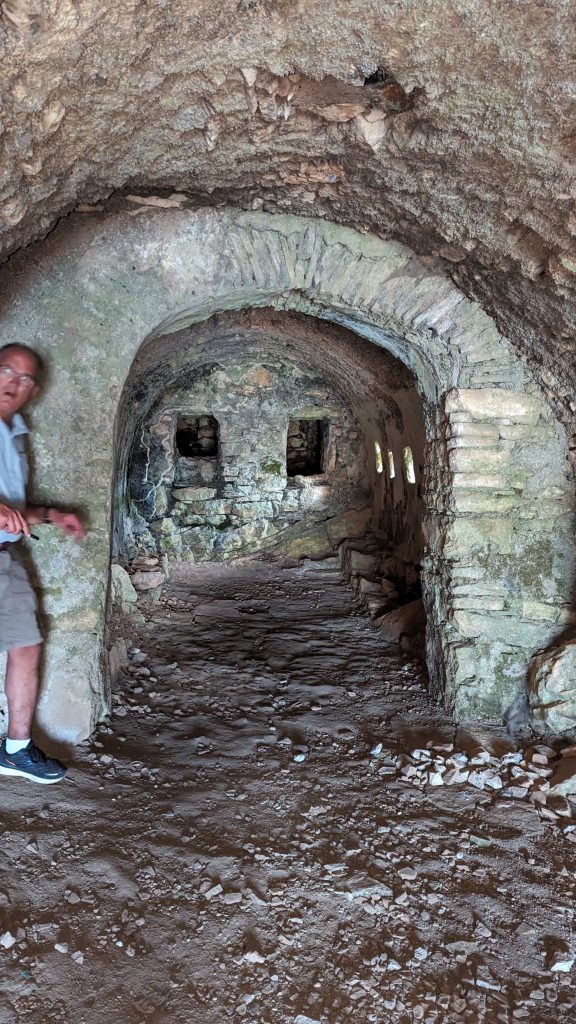
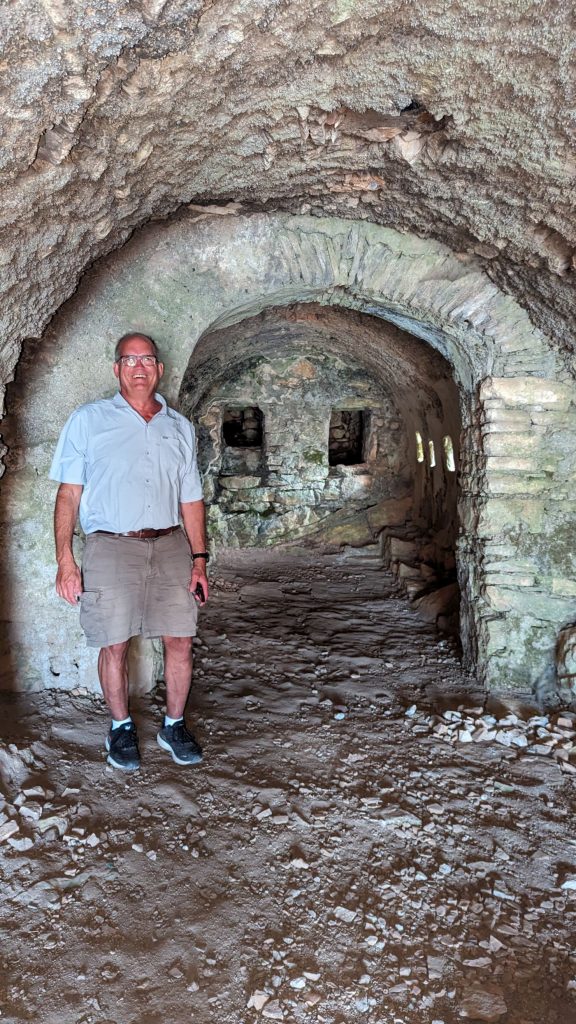
And now views from the monastery looking out at the sea and Sarandë.
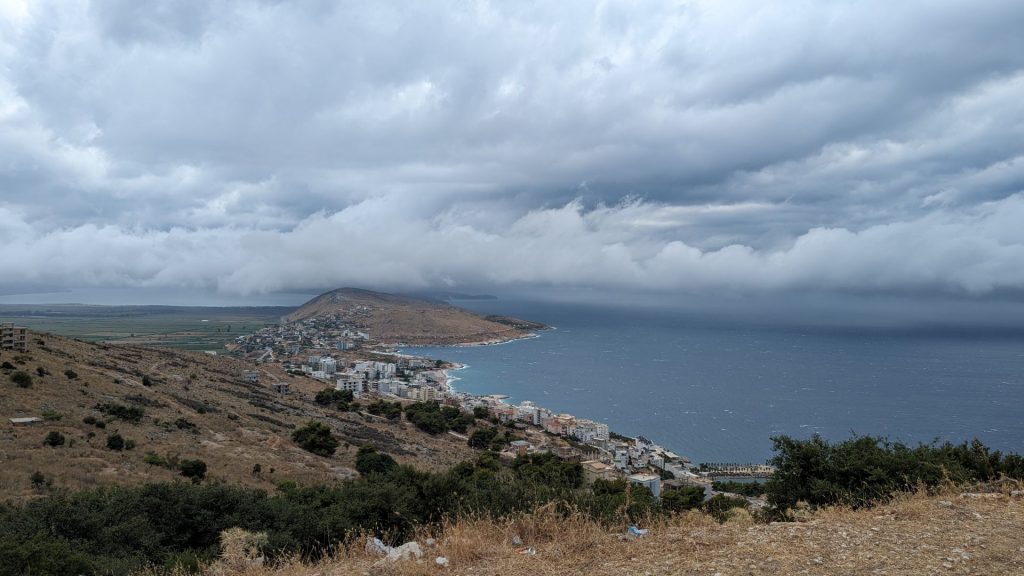
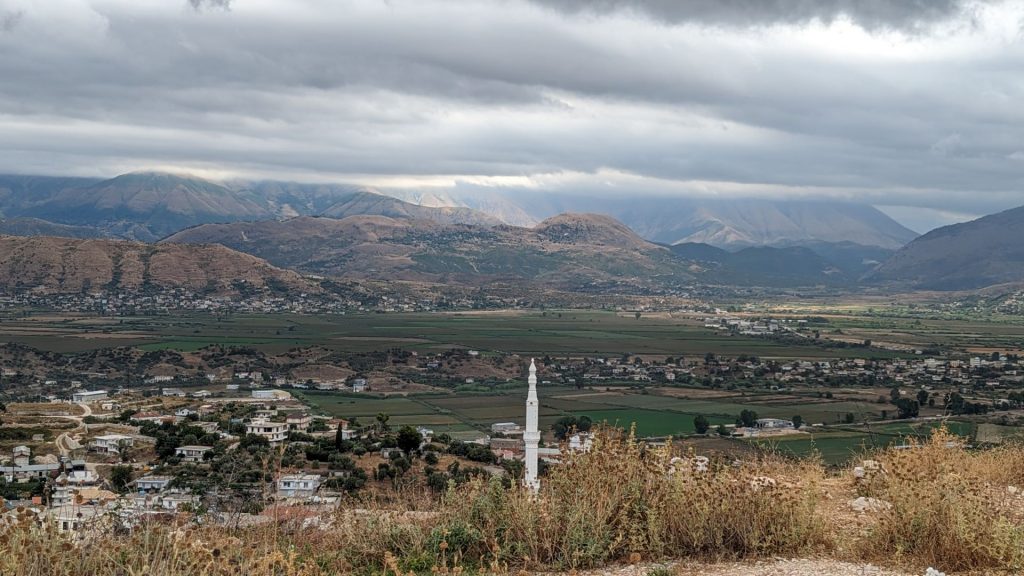
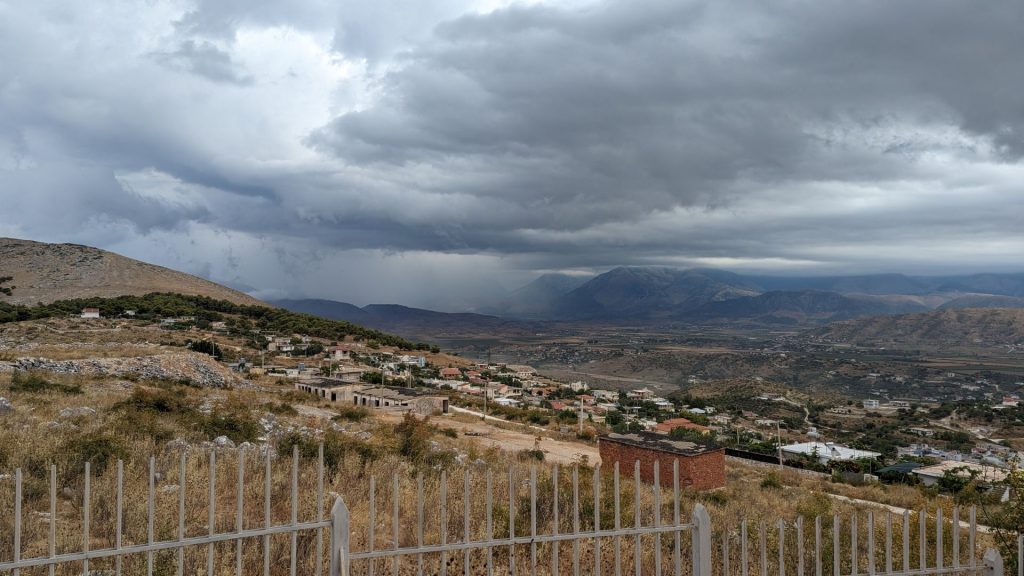
I’d read that there was a “kick ass” winery near the monastery and wanted to stop. Sadly, it didn’t open until 4:00 and that was a couple of hours away. So we went to our final stop before the hotel: Lëkurësi Castle. This turned out to be a very short stop because the former castle has been turned into a restaurant. We just took a few photos and left. Had this been a nice day, we might have come back for dinner to enjoy the sunset.
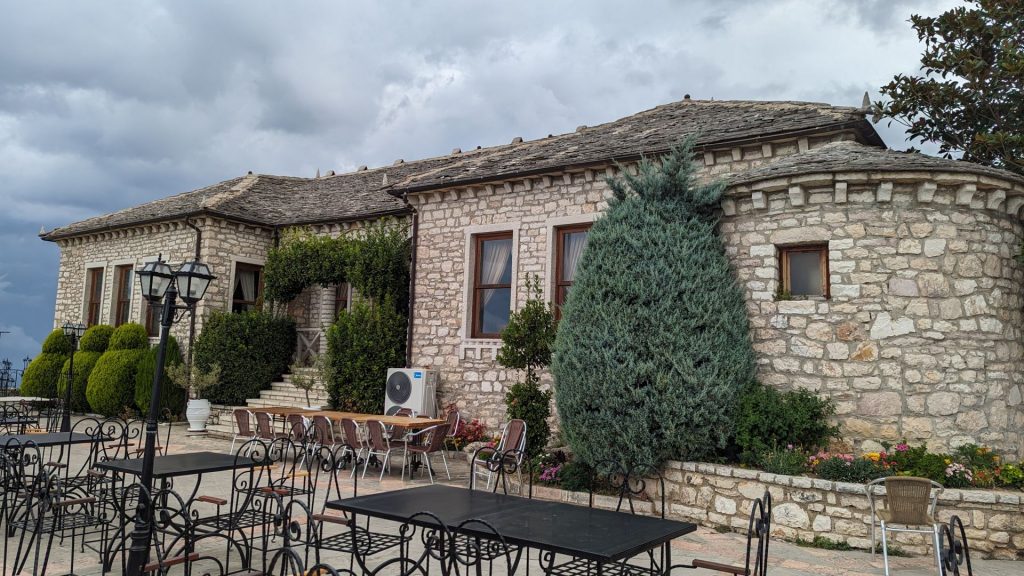
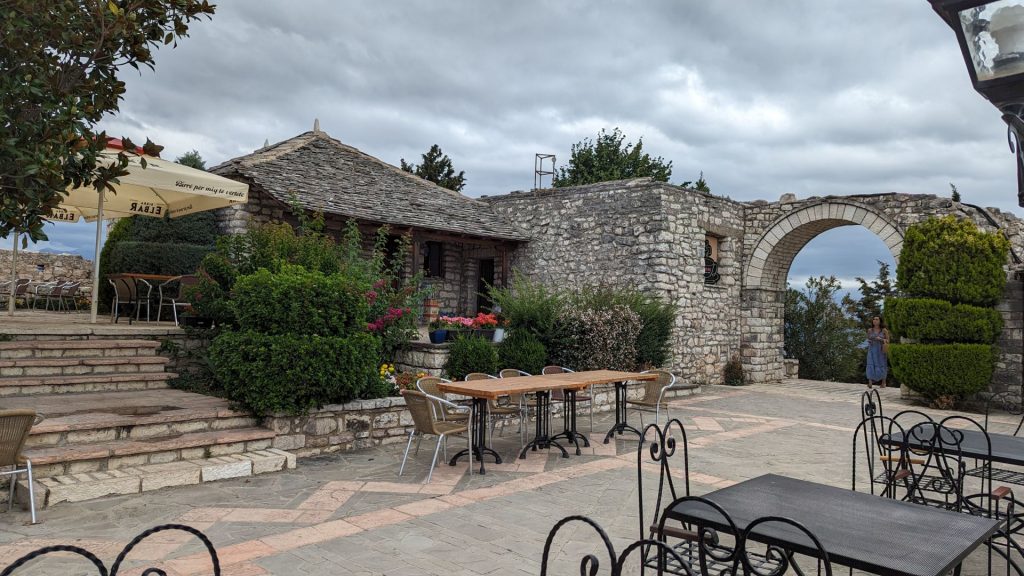
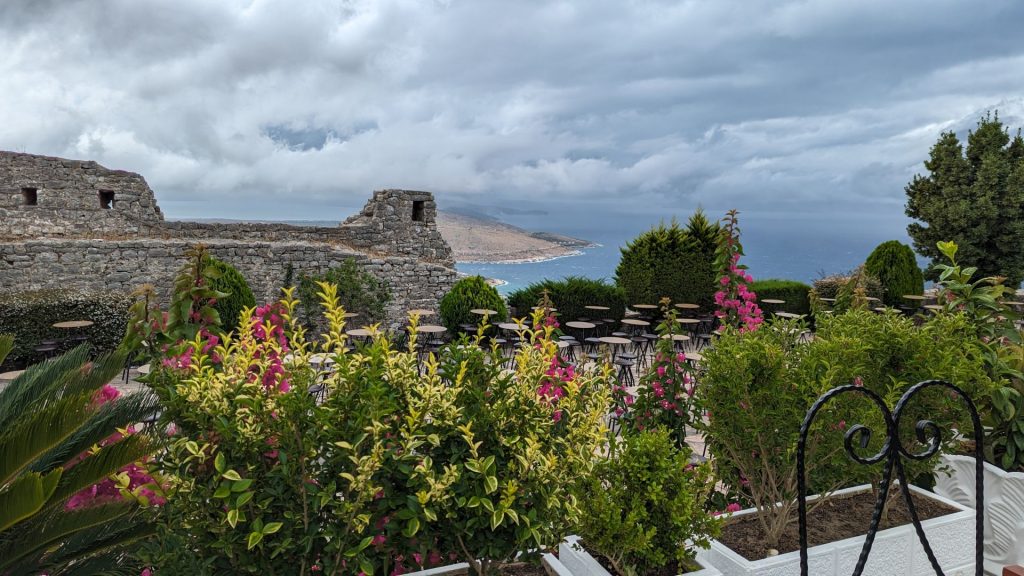
We stayed at Elite Hotel in Sarandë that night. We also enjoyed a happy coincidence. I’d read that a “don’t miss” restaurant in Sarandë was Haxhi, but I had neglected to check its proximity to the hotel. It was less than a 20 minute walk. Whew!
(I should mention here that between arriving at the hotel and going to dinner I spent an hour on the phone with an Expedia rep fixing the still broken hotel reservation. At that point, we had no place to stay the next two nights. By the end of the hour we had a reservation at Hotel Fantasy in Gjirokaster.)
What struck me initially was the fun and entertaining décor. But the food was also amazing.
VEGAN ALERT: FISH PICTURE AHEAD.
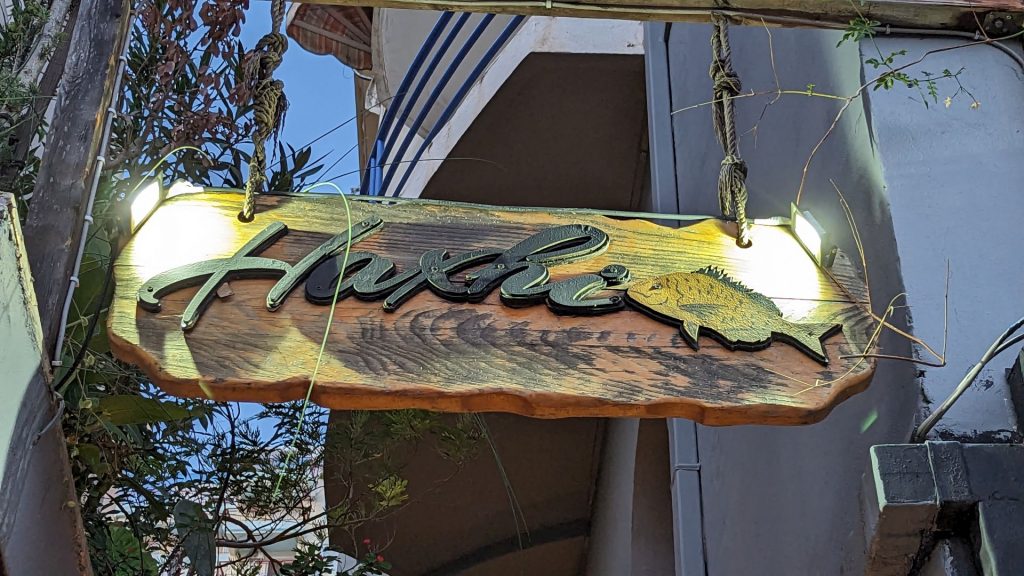
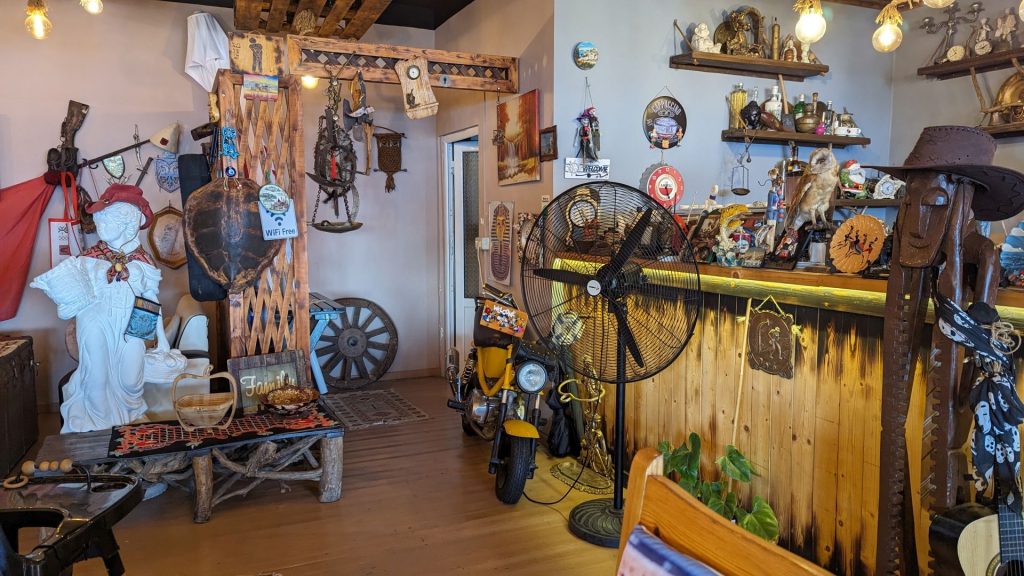
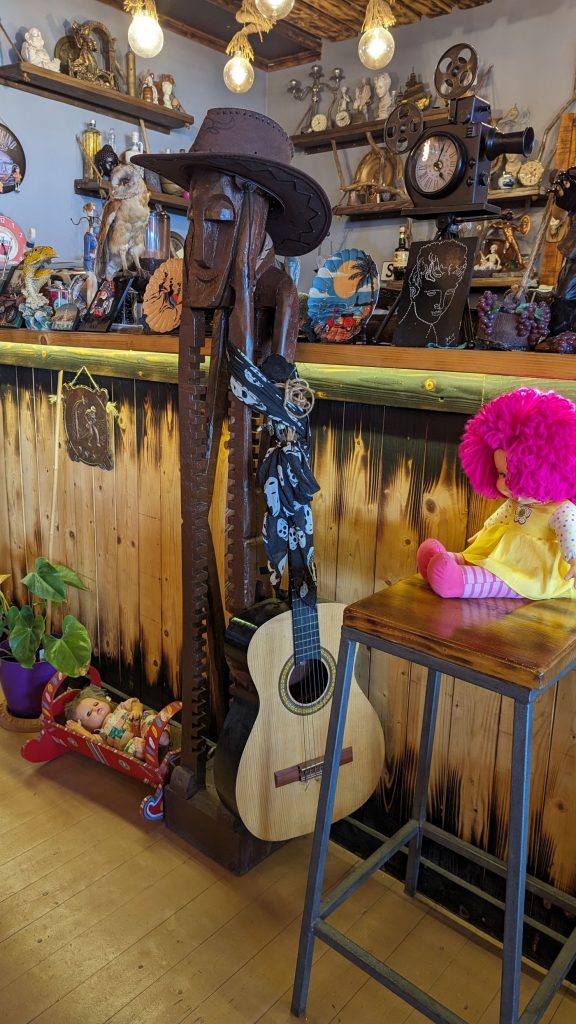
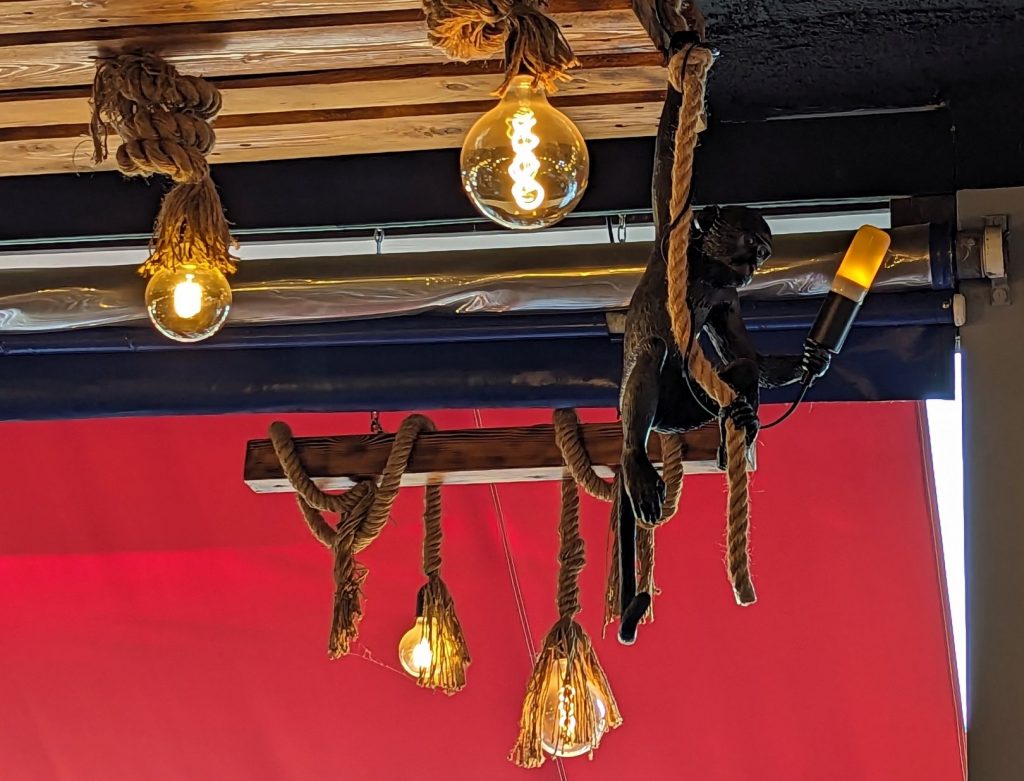
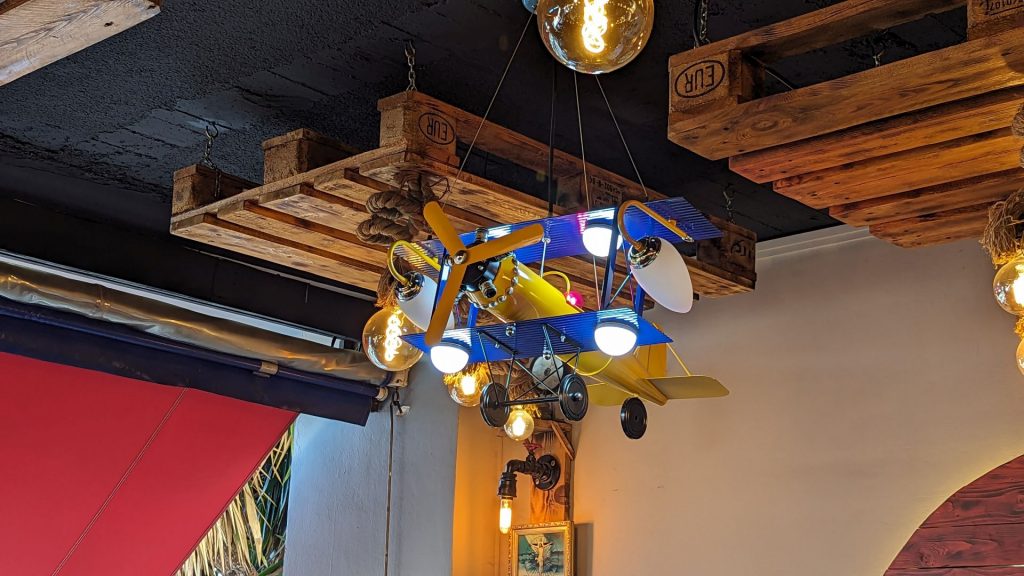
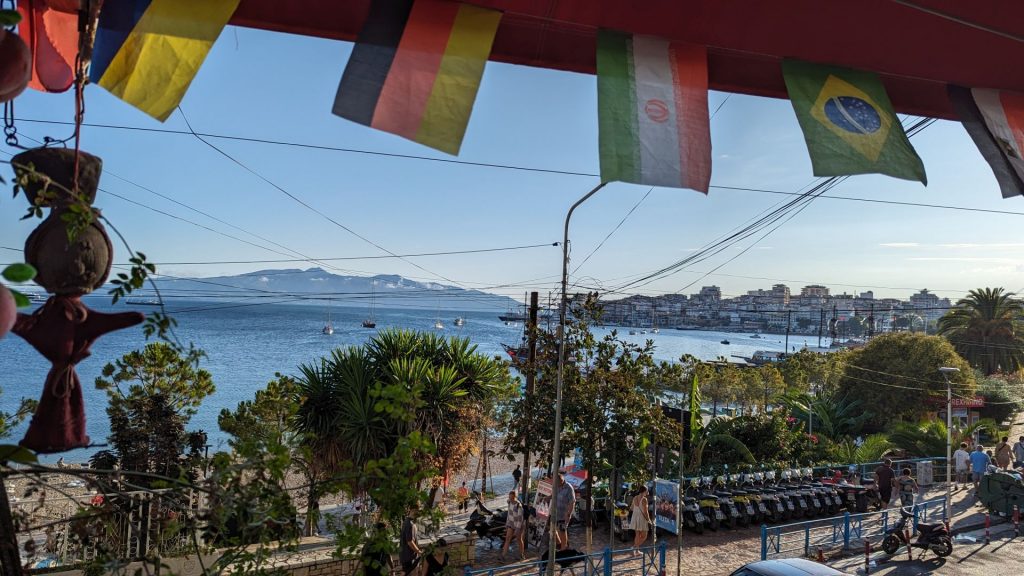
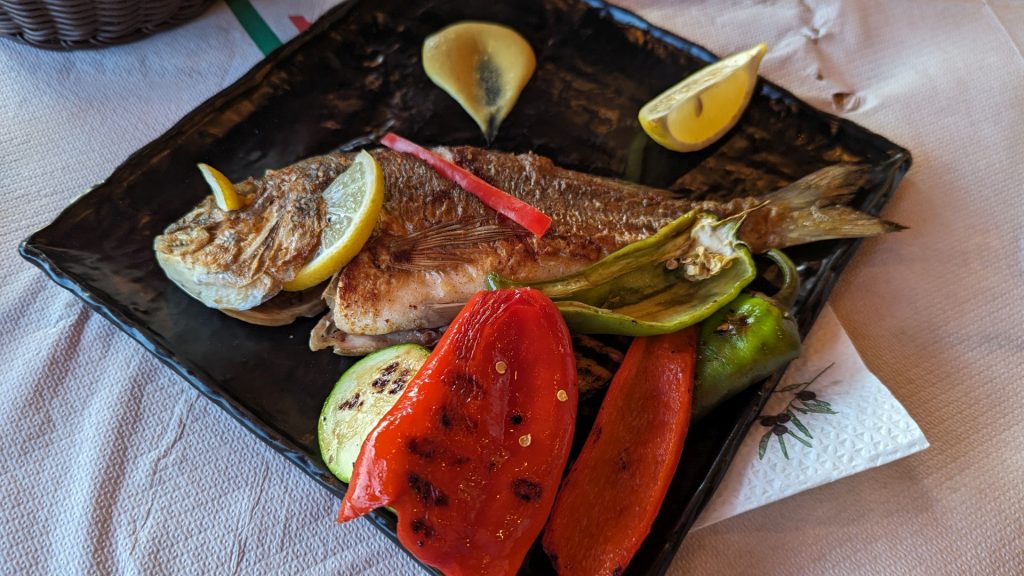
Check out our next post for day three’s adventures!
